John Deighton, from the town of Hull in northern England, was variously a sailor, a gold prospector, and a bar owner. Among his contemporaries, though, he was best known as a talker, which earned him his ‘gassy’ nickname. As a loquacious English-born mariner and riverboat skipper on the Fraser River who moved to Burrard Inlet in 1867 and opened a saloon here. The small logging community came to be known as “Gastown,” after him.
The saloon served workers at nearby Hastings Mill, established in 1865 to process timber from the vast forest that once covered present-day Vancouver. It became the focus of a budding settlement, which the colonial government surveyed in 1870 and officially called “Granville” for the British colonial secretary, Earl Granville.
The settlement’s future was secured when William Cornelius Van Horne, general manager of the Canadian Pacific Railway, decided in 1886 to extend the tracks from Port Moody to a terminus just west of here (H28). Van Horne is credited with naming the transcontinental terminus “Vancouver,” to honour the Royal Navy’s Captain George Vancouver, who charted the inlet in 1792.
The rudimentary community (population around a thousand) was incorporated as the City of Vancouver on April 6, 1886, and promptly destroyed two months later by the “Great Fire,” caused by forest-clearing burn-off blowing out of control.
The settlement was rebuilt with brick- and stone-faced, timber-framed hotels, stores and warehouses that reflected the growth of the young shipping and commercial centre that would soon eclipse Victoria.
The Klondike Gold Rush at the end of the century added distinguished architecture, much of which survived changing patterns of trade, transport and industry that caused Gastown’s gradual decline.
In 1885, a new street grid was laid out west of Cambie Street by CPR surveyor Lauchlan Hamilton. His deviation from the survey of 1870, best seen at Victory Square, still marks the urban frontier between the new and old downtowns, much of the latter now dismissed as the Downtown Eastside (DTES). Centred along Hastings Street from Cambie to Main, the DTES had been the city’s early commercial centre. Its architecture exhibits past prosperity. Decades of economic decline and neglect left Gastown and the DTES a shambles assaulted by chronic social problems.
Gastown’s revitalization began in the late 1960s, when citizen protest cancelled a planned freeway that threatened the area, and community action led to some old buildings.
The 1971 “Gastown Riot” (commemorated in an artwork in the Woodward’s atrium) followed arrests by police undercover drug squads.
Despite change, homelessness, drugs and despair prevail in the Downtown Eastside. A catalyst for the long-awaited solution is the momentous Woodward’s redevelopment (A25), an innovative project that seeks to break social barriers. It also breaks physical ones, with two high-rise towers in a historic setting. Woodward’s is a big fix for the Downtown Eastside, but smaller creative enterprise is introducing edgy retail and chic residential conversions, to the concern of many low-income residents.
Non-conformist behaviour—and the present social tensions in the Downtown Eastside—are rooted in Vancouver’s origin as a logging settlement and seaport and to the individualism that founded its most popular early building: Gassy Jack’s saloon.
Today, the site of the saloon could not be further removed from the spirit of the past: it is now a polished Gastown heritage conversion that mixes hip retail and loft-style dwellings.
Pioneer life stories (or legends) have a tendency to be colourful, and Gassy Jack’s is no exception. Born in 1830 in England, Jack Deighton went to sea at 14. He eventually wound up in the new colony of British Columbia, where he opened a saloon in New Westminster, up the Fraser River from present-day Vancouver. When that failed, he loaded a canoe with a bottle of whisky, a few sticks of furniture and a yellow dog and paddled to Burrard Inlet, where he began selling whisky to loggers at the new mill. In 1867 thirsty loggers helped him build the Globe Saloon—in 24 hours as legend has it—and Deighton’s bar thrived. His nickname? Supposedly it refers to his never-failing willingness to tell a tale. A statue of Deighton stands in Maple Tree Square at Carrall and Water Streets.”
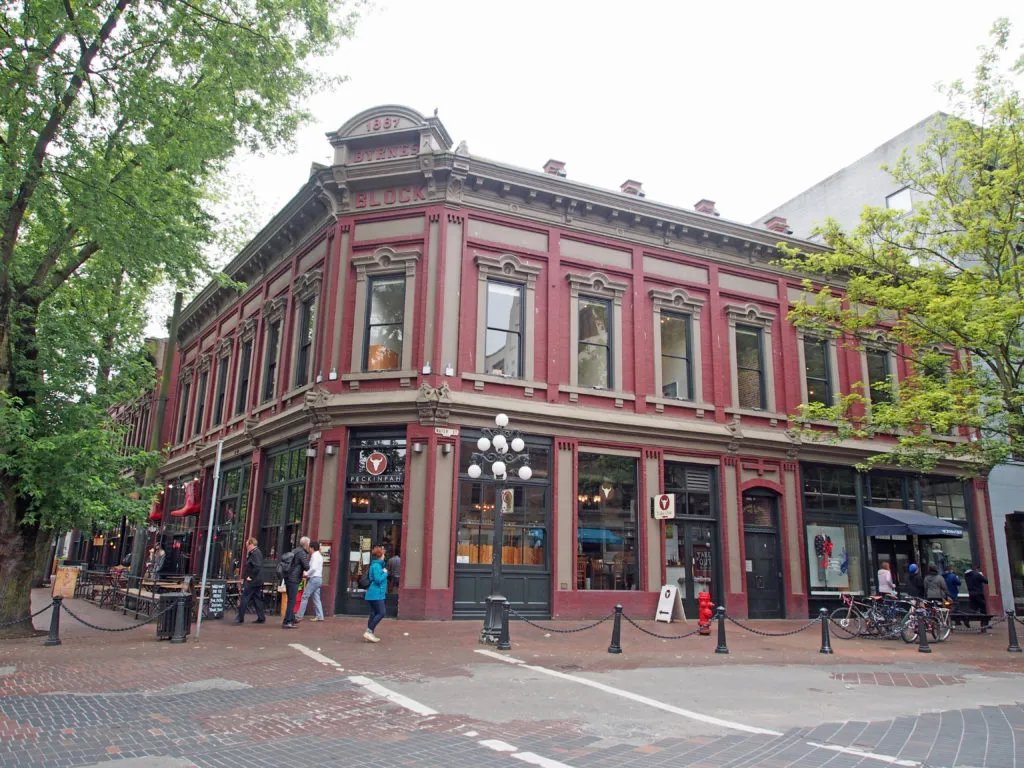
“Gassy Jack” Deighton, for whom Gastown is named, built a saloon in 1867 on this site on Maple Tree Square, Vancouver’s first outdoor public space. The present building was erected by realtor George Byrnes after the Great Fire of 1886. The Victorian Italianate frills—ornate window surrounds, top-floor pilasters and decorative cornice—announced it as someplace special. It was first occupied by the Alhambra Hotel, one of the few charging more than a dollar a night, justified by its claim to be “Vancouver’s most modern . . . with running water and a wood stove in most rooms.” The accommodation later dropped a few notches when it became the city’s first courthouse and jail (the name “Gaoler’s Mews” for the courtyard records this).
Architect Fisher, who claimed to have been born in Edinburgh and to have fought in the American Civil War, arrived in Victoria in 1886 by way of the American West and established a busy office. He then opened offices in Port Townsend and Seattle, exploiting the opportunity set by the latter’s fire of 1889, and designed that city’s finest Romanesque[…]”“Revival work, the Pioneer Building (1892).
The Byrnes Block has twice played a vital role in the revitalization of Gastown. Developer Larry Killam rehabilitated it in 1969, inspiring other property owners to give their dreary, run-down buildings facelifts and the City to upgrade the public realm. Some forty years later, renewed confidence in the district was shown by developer Robert Fung, who reinvested in the Byrnes Block/Alhambra Hotel and its four western neighbours—the Cordage Building (c. 1890) and Nagle Brothers Garage (12 Water Street, the latter by McCarter & Nairne 1930, originally two storeys), the Grand Hotel (26 Water Street, c. 1890), and the bay-windowed Terminus Hotel (30 Water Street, Bunning & Kelso 1886) which had been gutted by fire in 1998.
The stylish package included conservation, seismic upgrading, geothermal heating and salvaged building materials. Underground parking, retail and forty-six residential units (including new penthouse floors) added profitable density. At the rear, the elevations are contemporary (their height difference indicates the original lots). They face Blood Alley Square, created as part of an earlier heritage project that linked Gaoler’s Mews to Cordova Street with a passage through the Stanley Hotel (21 West Cordova Street, c. 1907[…]”
“Underground parking, retail and forty-six residential units (including new penthouse floors) added profitable density. At the rear, the elevations are contemporary (their height difference indicates the original lots). They face Blood Alley Square, created as part of an earlier heritage project that linked Gaoler’s Mews to Cordova Street with a passage through the Stanley Hotel (21 West Cordova Street, c. 1907; rehabilitated by Henriquez & Todd 1971).

Victorian Italianate with a trace of the frontier, this building was constructed for Alfred Graham Ferguson, a CPR tunnel contractor–turned-developer. It was one of the first masonry buildings erected after the Great Fire, which destroyed the pioneer settlement of Granville—a.k.a. Gastown—and its wood buildings (including Ferguson’s on this site) in twenty minutes. The fire started in Yaletown, where CPR crews were clearing land for the Round”
“clearing land for the Roundhouse (G20). Hastings Mill (C19), east of Gastown, was spared, and its manpower and lumber aided swift rebuilding. The new Ferguson Block became a focus for that effort because it housed the CPR land office, with the City Magistrate’s law office upstairs (it was extended south in 1889). Like other post-fire buildings, its structural materials were timber, stone and brick. Whiteway, a Newfoundlander, had his name carved on the cornerstone.

“Merchant Thomas Dunn, an alderman on the first Vancouver City Council, expanded his “Headquarters for Klondike Supplies” from the pedimented Lonsdale Block (8–28 West Cordova Street, N.S. Hoffar 1889) to this Romanesque Revival warehouse. The attic made it three and a half storeys, supported on interior columns. The rear portion was built at the same time; the east addition 1907. The building housed the office of the Union Steamship Company, whose dock was at the foot of Carrall Street.
“Vancouver’s pioneer architects were mostly a nomadic and opportunistic lot. Hoffar was typical. Born and educated in Washington, D.C., he mined in Nevada, learned the building trades in San Francisco and worked his way up the West Coast before settling in Vancouver in 1886. Here he found opportunity and a good supply of clients after the Great Fire.
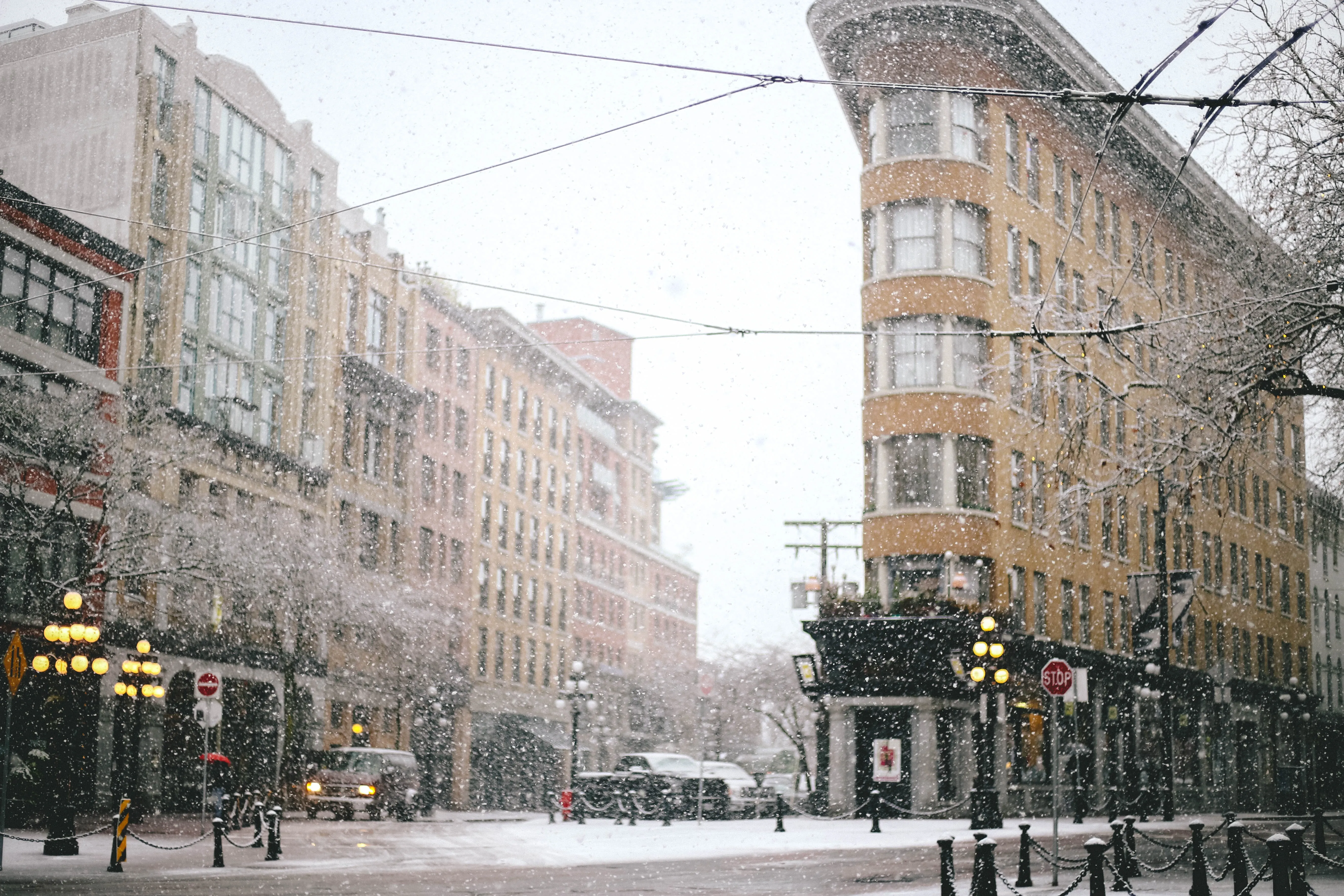
The hotel sails into this intersection like a ship parting a sea of traffic. It was built to a triangular “flatiron” plan for Italian-born proprietor Angelo Calori, whose name is above the entrance. The cornice caps six rather than the eight storeys intended. The contractor was the Ferro-Concrete Construction Company from Cincinnati, Ohio; this was the first reinforced-concrete building in Vancouver. Glass blocks on the sidewalks lighted “areaways,” which added space. They were filled with gravel by City Engineering in a 1990s safety campaign, lest trucks mount and collapse the sidewalk. Once noted for its palatial bar, the Europe was a decrepit rooming house when the Canada Mortgage & Housing Corporation stepped in to renovate it for affordable housing. Heritage features include a floridly tiled lobby, Ionic-columned window mullions on the curved prow and the conspicuous cornice. Calori’s adjoining, earlier Europe Hotel (49–51 Powell Street, 1886; 1890; Adolph Ingre & Associates 1983), has twin, vaguely Venetian elevations, one on Powell, the other on Alexander Street. Enlarged westward in 1890, it was retained as the new Europe’s annex.
“Short, medium and tall warehouse façades lined the north side of this block for almost a century. The streetscape was so convincingly of the past that the producers of the 1994 movie Legends of the Fall hardly needed to dress it as a stand-in for Helena, Montana, c. 1910. The film could not be shot here now. Only the Captain French Building (41 Alexander Street, Parr & Fee 1909; Paul Merrick Architects 1990), named for its first owner, a tugboat skipper, retained its original height during loft conversions on the block.
“There is a contextual justification for add-on lofts: extra floors were fitted to many of Gastown’s buildings during the Edwardian economic boom. Additions increase density, an aspect of the City’s heritage management that evolved after the provincial government, at the City’s request, designated Gastown a historic district in 1971. That led to renovations and streetscape improvements. Planners have since tried to balance conservation with the commercial investment and changes of use that keep the buildings alive. Contemporary interventions are now accepted behind historic façades.

In a Gastown that is trendy, Inform Interiors is a design-led symbol of continuity. Its Danish-born designer, Niels Bendtsen, opened a store in the district in 1970. His modernist furniture, crafted in a converted warehouse on Railway Street (C20) four blocks east, continues a manufacturing tradition in Gastown that goes back to the nineteenth century. This showroom for owners Niels and Nancy Bendtsen retains the cornice, concrete blocks (cast to look like stone) and storefront I-beam from the Kane Building, as the structure was first known. A green roof has ” “been added. Designer and project architect Omer Arbel introduced concrete floors and columns (to replace wooden posts), and a skylight to illuminate the see-through showroom’s contemporary furniture and twentieth-century design classics. An elegant new stair structure is poised in the centre of the showroom.
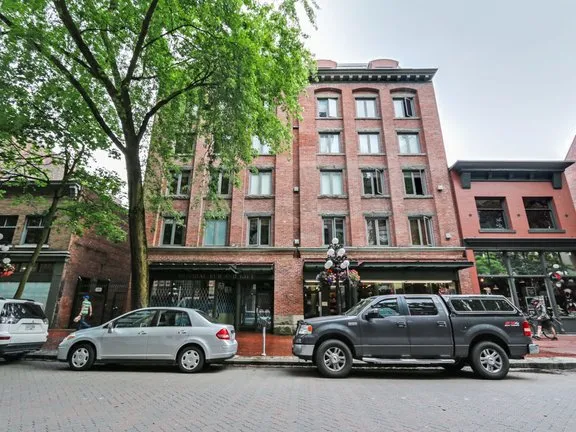
“Wholesale grocery magnate and sometime mayor of Vancouver William Harold Malkin built this brick-clad, Douglas-fir-framed structure—his third warehouse on Water Street in a decade of thriving business (his previous, smaller warehouses are at 353 and 141 Water Street—see A9). The building was extended to the east in matching style, doubling the floor space. This part of Water Street was the hub of grocery distribution until the 1930s, when many of these big buildings were taken over by the garment were taken over by the garment trade. Rehabilitation as live–work studios by developer Jon Stovell’s Reliance Properties included a seismic upgrade, an under-ground parkade and a lofty glazed retail space on an empty lot to the west.
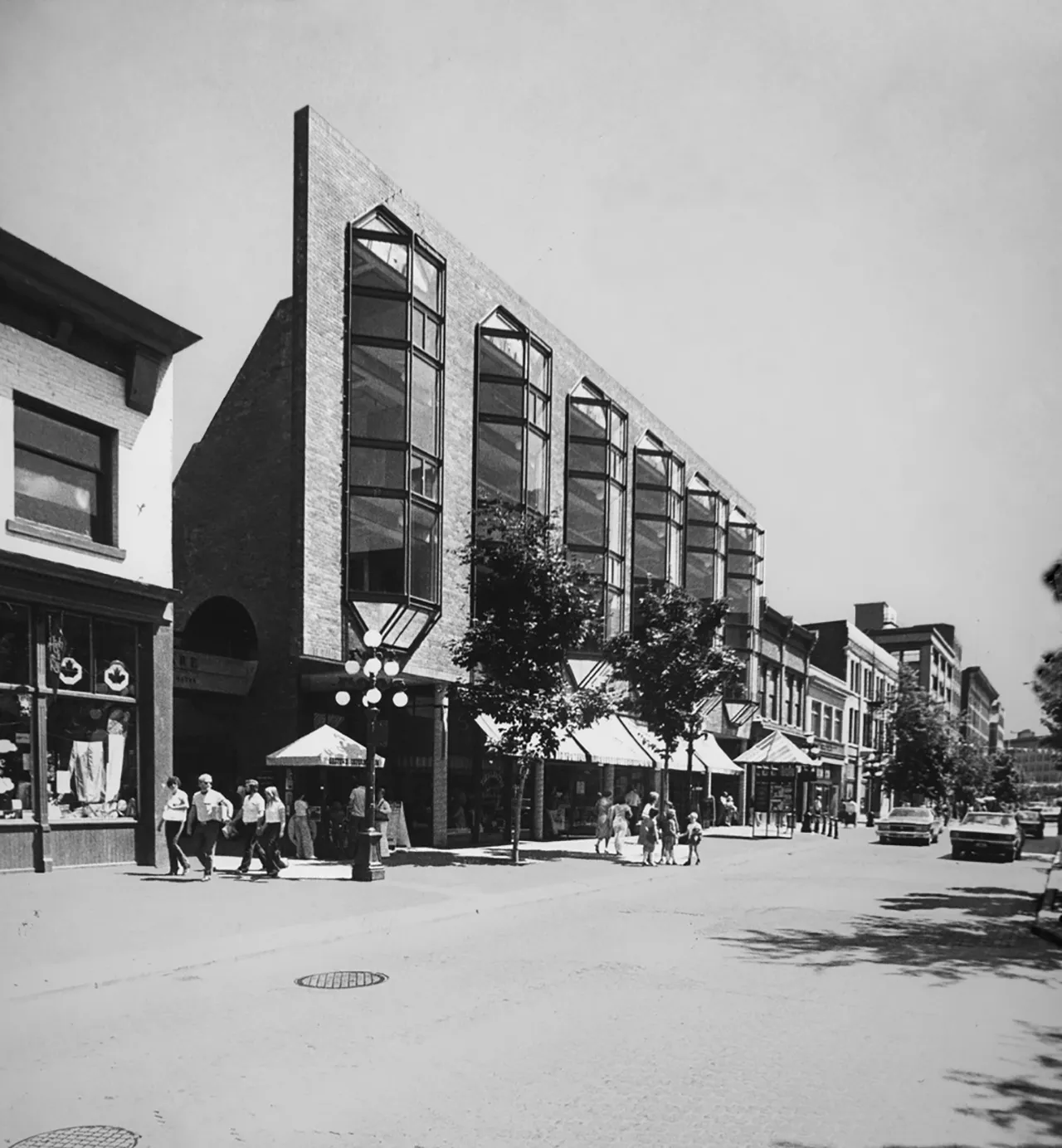
The CPR’s Marathon Realty developed this infill site, a concession to a revitalized Gastown after their Project 200 (A17) urban renewal scheme in the late 1960s failed. Project 200 caused “planning blight,” as building owners were unwilling to maintain properties likely to be torn down. Gaslight Square, the first new building to recognize Gastown’s historic character, gave a lesson in how to stitch the district together.
Early postmodern with a façade rendered at its western edge as a faux false front, it is a reinterpretation of the Wild West–style false fronts on the wooden buildings destroyed in the Great Fire. The use of brick is contextual; bay windows echo those on the Terminus Hotel (A1). Behind the façade, a modernist glazed roof slides away to a split-level courtyard with retail and offices. Across the street, Gastown Parkade (150 Water Street, Paul Smith 1971; Henriquez Partners Architects 2005), originally part of Project 200, was rebuilt with contextual elevations, to fit the streetscape’s historic character.
“Water Street is aptly named: the backs of the first warehouses on its north side were supported on wooden piles along the shoreline. Boardwalks connected to a CPR trestle above the water on the tidal strip parallel to the street, allowing freight to be off-loaded from boxcar to building. The back of this block was built on piles. Its loading bays faced tracks laid when the trestle was dismantled and the land reclaimed around 1900. Three east bays were added (the Klondike boom saw many structures in Gastown enlarged). A condo rehab included mansard-roofed lofts, set back, sensitive to the streetscape.
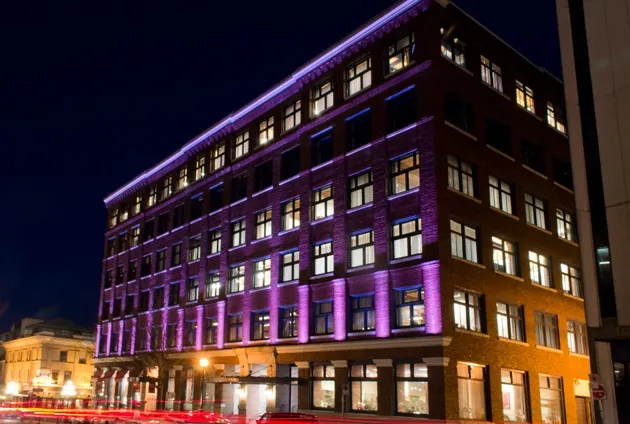
“Around 1900, Vancouver overtook Victoria as B.C.’s main trading centre. Canneries, mineral strikes (particularly the gold in the Klondike) and logging operations were supplied from, and many products manufactured, here. The Leckie Building is a symbol of that commerce because its owner made what every logger needs: a sturdy pair of boots. John Leckie, a Scottish immigrant, founded the company whose boots were “The Best in the West,” so a rooftop sign claimed. The building, framed with cedar posts and beams behind load-bearing brick-and-masonry walls, was converted to offices by Novam Development, which pioneered warehouse makeovers in Vancouver. The work included a seismic upgrade, unique in the city at the time. Steelwork anchored in concrete 27 metres below grade braces the structure; two tension rods crossing diagonally on each elevation were exposed to allow the ingenuity to be seen.
“The CPR in Vancouver connected to the company’s coastal and trans-Pacific shipping routes. Its train station (H28) and piers were built on the western edge of Gastown. Almost as many hotels were built in the district as there are warehouses. The Edward replaced the wood-frame Regina Hotel, one of the few buildings saved during the Great Fire. Romanesque lingers in the rusticated stone bands on the elevations here, but the feel is Italianate, almost like a miniature palazzo (with a sheet-metal cornice). Prestige was sought with façades clad completely in stone, expensive and uncommon. The ground floor retains its cast-iron columns, I-beam headers with cast rosettes and storefront articulation and glazing. A bistro continues the tradition of hospitality.
“Horologer Raymond Saunders and metal-work specialist Doug Smith (at the Vancouver Technical School) designed and fabricated this faux-antique, allegedly steam-powered clock, funded as a business improvement to put Gastown on the tourist map. Only the whistle, which toots the chimes of Big Ben, is activated by steam. The steam is generated at Central Heat Distribution’s plant (720 Beatty Street) and delivered by underground pipes, a network that also heats many buildings downtown. The adjacent globe-clustered street lamp is of nineteenth-century design, introduced as a “heritage” feature in Gastown in the 1970s.
Turn left onto Water Street, lined with trees and restaurants; MeeT, see 2 [map], for vegans and the Flying Pig, see 3 [map], for meat-eaters are good places to refuel.
At Cambie Street, glance to the right for a view between the buildings of the harbour, then turn your attention to the Gastown Steam Clock 5”
“that stands on the corner. This remarkable Edwardian-style timepiece was built in 1977 by master horologist Raymond Saunders, and has fascinated pedestrians ever since. Its location on top of a steam vent was deliberate; the steam doesn’t actually power the clock but it does operate the four pipes that turn out a rather breathy version of the Westminster chimes tune, and then marks the hour by shooting steam upward through a fifth pipe on top of the clock. If you are wondering how this complex contraption can possibly keep time, here’s the secret: it does its best, and then an electric backup ensures that complete accuracy is maintained.
Continue along Water Street, with the Vancouver Lookout (for more information, click here) coming into view ahead. At the end of Water Street, go right on West Cordova Street, and Waterfront Station is on the right.”
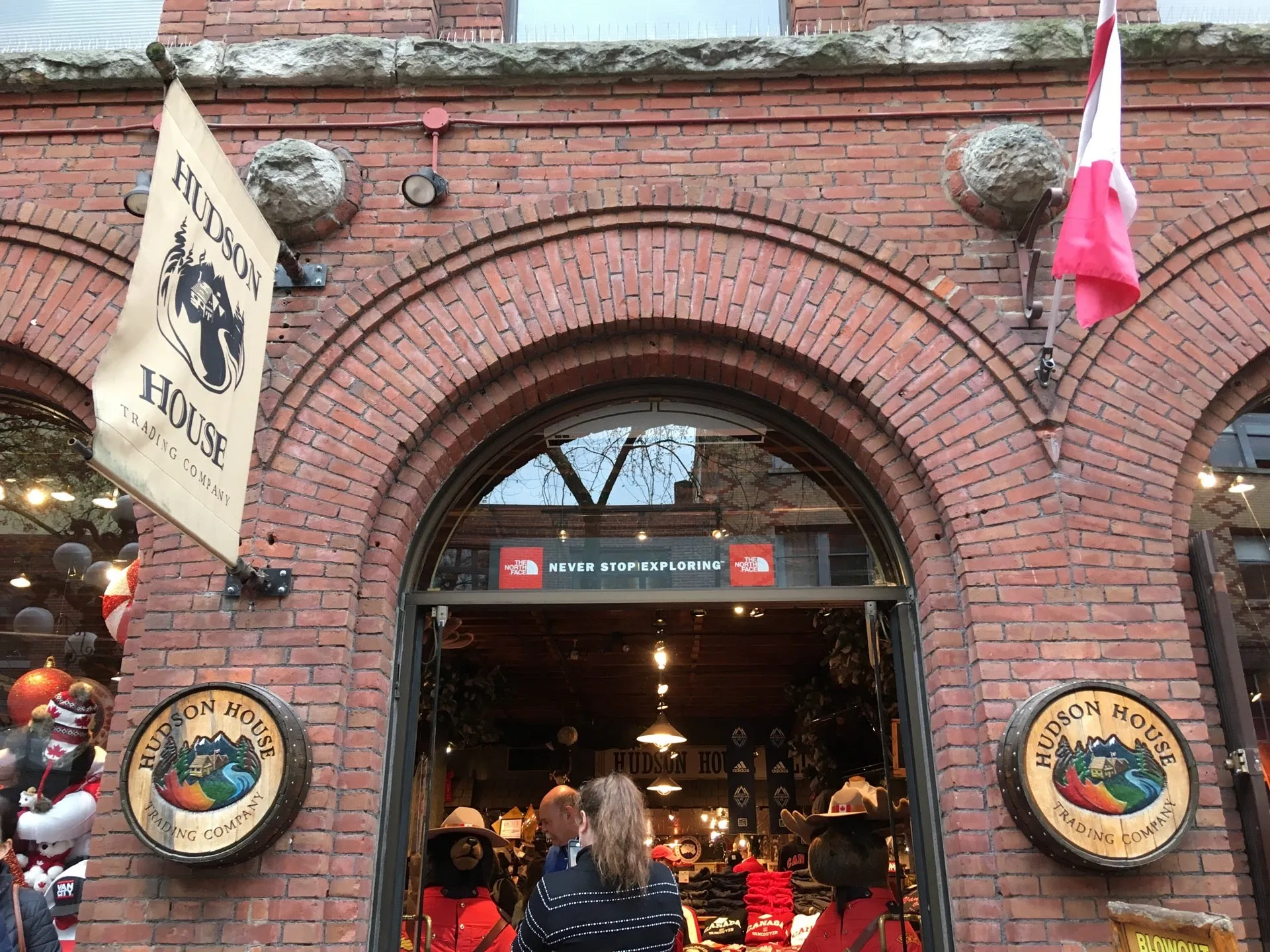
“This former Hudson’s Bay Company fur and liquor warehouse—and the Greenshields Building across the alley (341–345 Water Street, 1902; 2004)—symbolize Canada’s pioneering westward expansion. The HBC’s fur traders opened the West; other merchants followed, particularly after the CPR was completed. Wholesaler Greenshields was founded in Montreal and expanded west; the Water Street warehouse is attributed to J.H. Cadham, architect of the company’s building in Winnipeg.
The HBC warehouse was enlarged by two storeys, added after the Klon-dike boom. Their arched windows sprang from the existing piers; twin pediments were aligned vertically with the street entrances. Both buildings were inspired by the Marshall Field Wholesale Store (1887), a now-demolished Chicago landmark, which was designed by Henry Hobson Richardson, the master of the Romanesque Revival in America. The repetitive arch-and-spandrel window treatment here is characteristic of the style; so too the shallow, corbelled cornices and the rusticated and carved stonework, especially at sidewalk level. The Greenshields Building’s carved capitals, representing indigenous and immigrant peoples, are particularly fine.
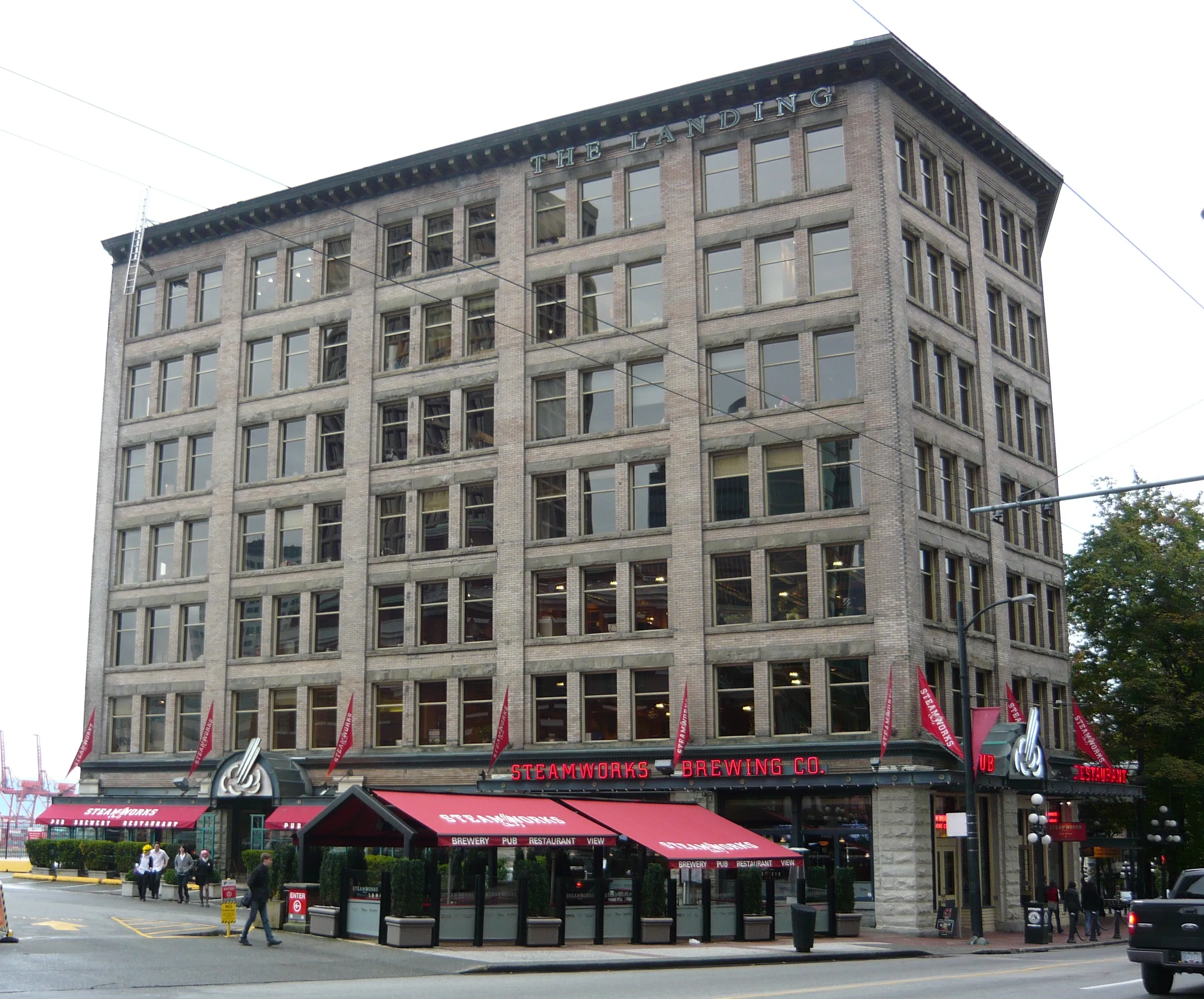
“Robert Kelly and Frank Douglas formed Kelly, Douglas & Company in 1896. It supplied Klondike gold rush prospectors, became known for its Nabob-brand tea and coffee and grew to be one of the biggest grocers in the Lower Mainland. This building, enlarged to the west within a few years, was the largest produce warehouse in the country. It was timber framed. Steel-frame (A19, A23) and reinforced-concrete construction (A4) soon superseded wood for buildings of this size and larger. The McLean Group rehabilitated it as offices, shops, restaurants and a brew pub, with a picture window inserted in the north wall to open up views of the harbour and North Shore.
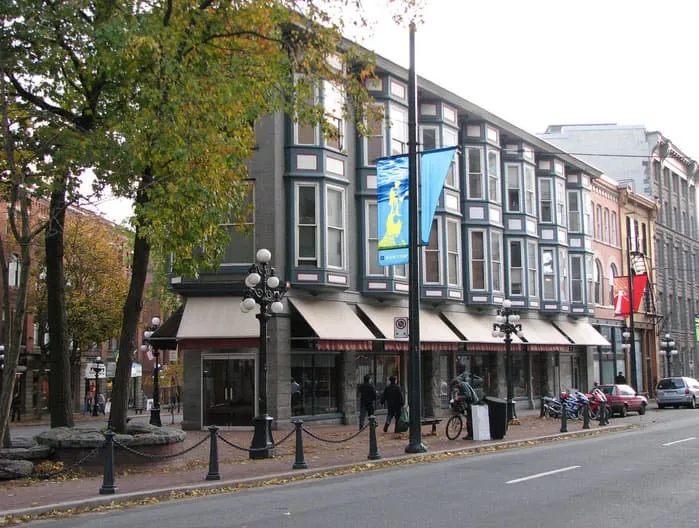
“The street grid of downtown Vancouver, laid out after a survey by the CPR’s Lauchlan Hamilton in 1885, joined that of the Granville townsite at an angle. The shift between the two grids is visible in the flatiron shape of the Holland Block, built for developer James M. Holland at the western entrance to Gastown. The style is Italianate in the San Francisco manner, with a projecting roof, originally curved above corner bay windows, which flow back on both façades. The storefronts are framed in cast iron, with the B.C. Ironworks trademark on the base of the columns.
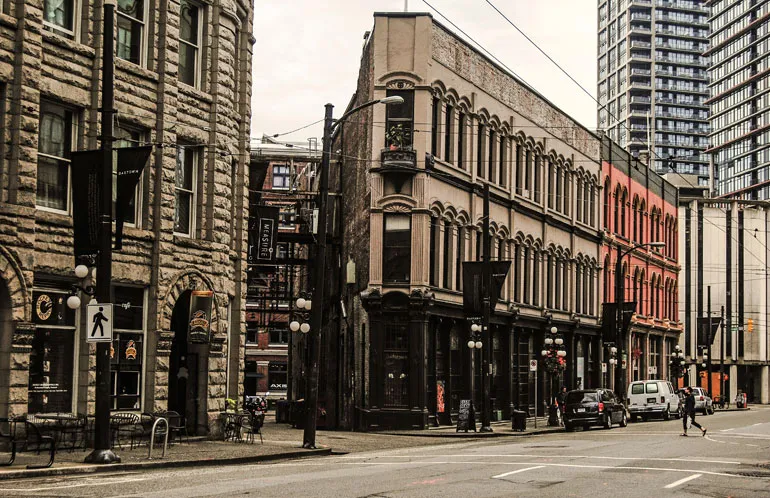
“This Italianate caprice, flatiron in shape, was originally decorated with a classical cornice, half-moon pediment, balustrade, cast-iron filigree and a cupola that defined the one-bay corner where only a “Juliet” balcony survives. Vancouver City Foundry made the cast-iron storefronts, whose capitals display an “H,” not for the architect but for Toronto-born owner James Welton Horne, who arrived in 1885 and profited from real estate during the post-CPR boom.
The abutting Springer–Van Bramer Block (301 West Cordova Street, N.S. Hoffar 1888), once known as the Masonic Temple for its tenants, is also Ital-ianate, angled to the street corner. As with the Horne Block, its weathered cornice was removed for public safety. The owners were tugboat captain James Van Bramer and Ben Springer, manager of the Moodyville sawmill on the North Shore.
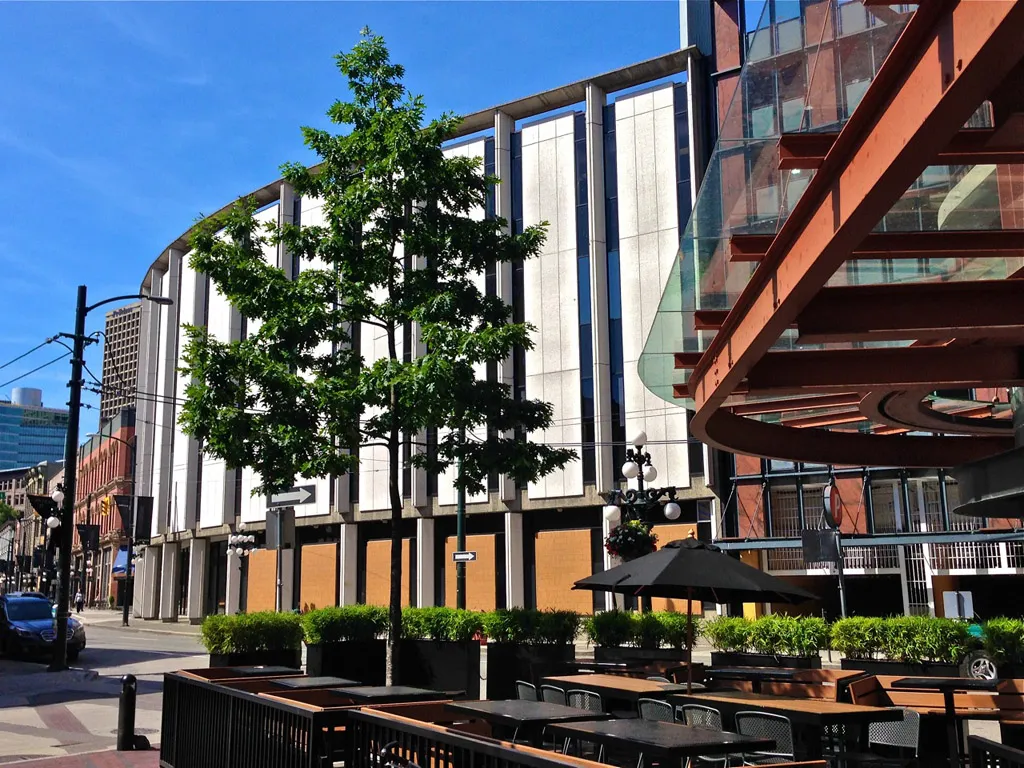
“The architecture of this building was influenced by the “New Formalist” style, a pseudo-classical offshoot of modernism, expressed here with a vertically finned curtain wall that turns the street corner gracefully. It is one of two structures by Donaldson (H29) for Project 200, proposed by Marathon Realty, department stores Woodward’s and Simpsons-Sears and Grosvenor-Laing Investments, inspired by the sweep-the-old-stuff-away mania of post-WWII urban redevelopment.
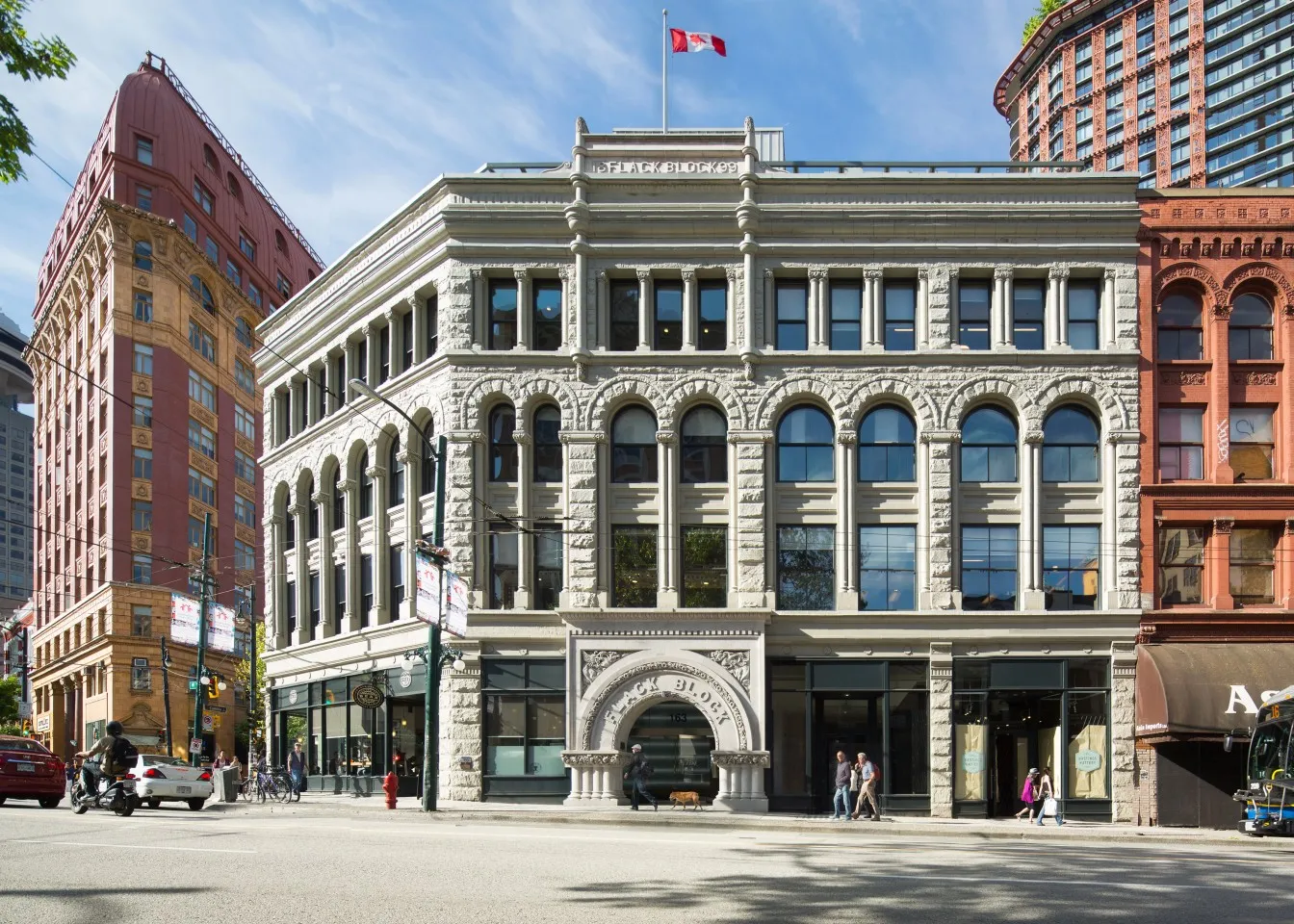
Thomas Flack struck it rich in the Klon-dike, sold his claim and expressed his good fortune in this Richardsonian Romanesque commercial block. The tripartite,granite façade with twin-columned articulation commands the corner facing Court House (now Victory) Square. Time was not kind to its status as a preferred location for lawyers, mining, logging and insurance brokers, gold dealers and retail tenants. When developer Robert Fung’s Salient Group took it over, a marijuana grow-op and rooms of stolen goods were discovered, and misguided modernization had destroyed the ground floor and cornice.
Hastings Street was massively (for the time) redeveloped in the late 1940s, just after WWII. Many shops were rehabbed with modern glass-and-aluminum storefronts and neon signs. The lower part of the terracotta and brick-faced Ormidale Block (151 West Hastings Street, G.W. Grant 1900), also Richardsonian, was altered in this way. The Flack Block shows how such buildings can be revived. Salient’s thorough and tasteful renewal included seismic and mechanical and electrical system upgrades, as well as a steel-and-glass rooftop addition. The elevator cage within“ the staircase was retained as a memory. The name was restored to its position above the cornice and to the main entrance, where the long-lost sandstone archway was accurately reconstructed.
“The Imperial Trust Company promoted this steel-frame, brick- and terracotta-clad extravaganza as “an object of pride to every citizen [of the] most prosperous go ahead commercial city on the continent.” The firm promptly went bust, and its debt was taken over by Dominion Trust, which finished the colourful landmark, briefly the tallest office building in the British Empire. The roofline looks French and the elevations are flamboyantly classical, in the early skyscraper manner. Two titanic granite columns mark the main entrance, which is recessed and richly appointed. The interior retains its marble, terrazzo and wood finishes and ten-storey staircase.
“Soldiers, sailors and aircrew killed in two world wars are commemorated by this obelisk, which follows the precedent established with the Cenotaph in London (Sir Edwin Lutyens 1920). Lutyens’s cenotaph is four sided in response to the urban design of Whitehall; Sharp’s three-sided version reflects the shape of Victory Square, a recruiting ground during WWI and where Remembrance Day ceremonies are held. The Cenotaph’s “steel” helmets and formality inspired Pechet & Robb’s Victory Square Lighting Project, a public realm enhancement encouraged by the Friends of Victory Square.
“This truncated Chicago Style building was built for Edgett Brothers, retail and wholesale grocers. It was linked, in 1924, by a bridge across the alley to the Province Building (198 West Hastings Street, Cox & Amos 1909), home of The Province newspaper, for which it became the printing plant. (The Province Building, originally the Carter-Cotton Building, for the publisher of the News-Advertiser, is full-blown Chicago Style.)
Glass block lights on the sidewalk and a modern entrance are a clue to changes inside the old printing plant, where floors were opened up for an atrium, offices and public exhibition space for the Architectural Institute of B.C. In the boardroom, a 2-ton steel truss replaced a concrete column taken out to create a workable space. The truss, exposed along with fragments of the column to show how it was done, is a metaphor for whole approach, which was rational and remains visible. The old elevator hoist in the skylight shows the position of the shaft that was removed; high-tech fittings are a perfect foil to the original concrete, distressed from years of pressmen’s knocks.
“Robert Berwick and C.E. “Ned” Pratt, trained in modernism at the University of Toronto, joined the established office of Sharp & Thompson in 1945. The buildings that followed gained the firm a reputation as the most progressive in Canada (H48). The downtown campus of VCC (opened as the Vancouver Vocational Institute) was one of the city’s first International Style designs, with characteristic clean lines inspired by the seminal Bauhaus, itself a vocational school in Germany (Walter Gropius 1926). Three classroom blocks were positioned to create a sunlit courtyard. The original ele-vations and twin glazed stairs offset by symmetrical brick corners are intact.
“The World Building, as this was first called, summed up Vancouver’s Edwardian boom with an exclamation mark—a tower capped by a French Second Empire dome, from where the Michigan-born publisher of the Vancouver World, Louis Denison Taylor, could survey the city he would rule with Citizen Kane–style populism as a long-serving mayor. “There is no limit to the possibilities of this city,” he once declared. His tower succeeded the Dominion Building (A19) as the tallest in the British Empire. A huge globe was mounted on the dome. The terracotta caryatids supporting the podium’s cornice were cast in England and later inspired the name of the Nine Maidens Restaurant, from where their Rubenesque proportions could be admired.
The World was absorbed by The Vancouver Sun, which occupied the “Sun Tower” from 1935, adding a huge neon sign, recalled by “newspaper row” ex-reporter and author Pierre Berton as “electric blue; you could see it all over town.” The Sun (with The Province) relocated to 6th and Granville in 1965; both papers moved back downtown, to Granville Square (H29), in 1997 and their printing to a new plant in Surrey.
“A continuous row of Edwardian warehouses created this muscular streetscape, now lined with lofts behind the elevations. The trendsetter was Five-Fifty Beatty, a conversion of the Johnston Terminals warehouse by developer Robert MacIntyre, who was inspired by artists’ lofts in SoHo, the old garment industry district in New York. Behind its postmodern façade, original big spaces were adapted and brick walls and timber posts and beams retained. The project was the first in the city to convert a heritage building to strata apartments, aimed at reversing the decline of this downtown edge.
Freschi’s influence lingers all along the street, particularly at the timber-framed Bowman Block (528 Beatty Street, 1906; Gair Williamson Architects 2007), where floor plates were cut back from the front elevation to make two-storey lofts, with a modern two-storey roof addition set back to add floor space while preserving the heritage streetscape.
“Retail pioneer Charles Woodward built a flagship department store (W.T. Whiteway 1903) at Hastings and Abbott, with additions over the next seventy years covering most of the block. When the store closed in 1993, owing to the failure of the corporation, it had become a sad relic of the Downtown Eastside’s days as a busi” “business and transit hub (A29). The loss of the store highlighted the area’s social problems. The “Woodward’s Squat” in 2002, in which many of the neighbourhood’s homeless people occupied the store for months, protested these and the neglect of the district and raised awareness of its need for affordable housing.
In an attempt to jump-start revitalization, the City of Vancouver bought the Woodward’s site in 2003. City councillor and activist Jim Green had long promoted the idea that redevelopment should serve the existing community and sustain the memory of Woodward’s. Architect Gregory Henriquez and developers Westbank/Peterson Group responded with “a real village on one super-block” comprising three new building blocks and the rehabilitated original 1903–08 building. The project and its inclusive social ideals got a popular stamp of approval when the condos in the flatiron “W” Tower, evoking memories of the Dominion Building (A19), presold in one day in 2006.
Architecture dominates this utopian vision of homes and workplaces where people of all ages and incomes might co-exist harmoniously. The built form accommodates two hundred social housing units, five hundred market condos, Simon Fraser University’s School for the Contemporary Arts, offices for the City[…]”“and for non-profit groups, a daycare centre, retail, a bank (the first major bank to open in the area in a half-century) and federal government offices. Heritage and amenity density bonuses enabled the huge amount of floor space—about one million square feet.
The vertical and horizontal integration of this complexity is deft: the urban design, with sidewalk access points penetrating to a large atrium, opens the block to public passages, and green credentials are made visible on the “W” Tower’s steel “eco skeleton,” intended as a green wall. The two extant façades and the internal structure of the timber-framed, brick-faced heritage building were retained, with its period cornice and the painted names of the retail departments restored (Commonwealth Historic Resource Management, Jonathan Yardley Architect). The iconic “W” sign and tower, too deteriorated to reuse, were rebuilt on top of it, and the original “W” was preserved in its rusted condition on the Cordova Street plaza. An interpretative program including the sidewalk display windows and reuse of salvaged fragments from the old building—and calling the supermarket “Woodward’s Food Floor”—ensures that residents and users understand the heritage of the site and the neighbourhood. “The glazed atrium features a huge photomural of the 1971 Gastown Riot (Stan Douglas 2009).
Woodward’s Parkade (125 West Cordova Street, 1957; Henriquez Partners Architects 2005), part of the city-owned Gastown Parkade (A8), was rebuilt to feel safer and be more user friendly and was linked by a new bridge to the redevelopment.”
“The ground floor was once occupied by boot maker and shoe retailer Pierre Paris, an immigrant from the Basque region of southwest France; the Strathcona Hotel had the upper floors. Ghost signs on the exterior walls remained, along with a much altered façade. The revitalizing—some say gentrifying—influence of the Woodward’s project is evident in the conversion to condos. The building’s clear-span I-beams and brickwork were retained à la mode; the savoir faire includes a chic annex (Gair Williamson 2012), clearly contemporary but scaled to coordinate with the old building. Another revival is at 43 West Hastings (1899), where Save-on-Meats (1957–2009) was reopened (2011) by restaurateur Mark Brand as a deli-diner complete with the original flying pig neon sign.
The non-profit Portland Hotel Society(PHS) drove this project forward, with various government agencies. The archit-ects came on board after the PHS, which accommodates many of the Downtown Eastside’s “hard to house,” called Erickson, whose designs for the privileged are better known. The response rejected the brick-faced heritage look in favour of metal cladding, with bay windows contextual with those on the Pennsylvania Hotel (see next entry). The bays, which divide above a cornice, animate the utilitarian elevation, which is duplicated at the rear, as is the mansard roof. There are eighty-six single room occupancy (SRO) units, with residents supported by on-site staff. Cornelia Hahn Oberlander designed the back-court garden.
San Francisco urbanism ripples on the façades of what was originally the Woods Hotel, a classy hostelry-turned–SRO hotel. It has been completely rehabilitated, with façades restored for the Portland Hotel Society, which provided forty-four safe, clean bachelor suites for the needy. The Downtown Eastside was Vancouver’s “Skid Road” (a loggers’ term from the wood “skids” on which logs were rolled), which morphed from a haven for transient loggers to one for the transient poor. This building’s revival, besides the social benefits, saw the replication of a long-removed corner turret and a 1920s neon sign with the hotel’s later name. The Carrall Street entrance, previously boarded up, is first class—Romanesque Revival and original.
Around the corner is the Only Seafoods neon sign (1950), on the former Brunswick Pool Room (20–26 East Hastings Street, H.A. Hodgson 1911). It’s a classic diner, established by two Greek brothers; the “Only” dates from 1916. It changed hands around 1992 and closed in 2009, after police alleged drugs were being dealt on the premises. The sign was removed, restored (Pattison Sign Group 2011) and returned to its original location for the Portland Hotel Society, which has leased the restaurant.
“B.C. Electric’s interurban tram network, once the most extensive in Canada, was run from this head office and depot. Trams ran into the terminus through a clear span on Hastings Street; the first two arches on the Carrall Street arcade were open to the station concourse. The structure, with steelwork “fire-proofed” with concrete, was preloaded for additional storeys (one was added in 1945). The building accommodated three hundred workers. The company was the biggest employer in the area, whose decline was accelerated when the interurban services to the terminus ceased in 1955, and to the region in 1958 (also the year North Vancouver ferries, which docked at the foot of Columbia Street, stopped sailing). In the 1990s, the BCER Building was adapted for high-tech and media tenants.
The same architects’ Merchants Bank (1 West Hastings Street, 1913), a neoclassical pile of faded grandeur facing pocket-size Pigeon Park, was also designed for additional floors. The end of the Edwardian boom prevented any. The façade detailing is exceptionally fine. The building’s steel frame was angled to avoid the CPR spur line from Burrard Inlet to rail yards at False Creek. Steam locomotives crossed Hastings Street at this point “ until the Dunsmuir Tunnel was opened in 1931. The City’s Carrall Street Greenway, which follows the eastern boundary of the Granville townsite, revives the route as a pedestrian and cycle link between the creek and the inlet (in the 1860s, it was possible to paddle a canoe between the two at high tides).
Brothers David, Charles and Isaac Oppenheimer, members of a large family that hailed from Germany, immigrated to the U.S. in 1848 and arrived in B.C. in 1858. Charles Oppenheimer & Company, provisions, was founded in Victoria around 1858, with a second store around 1860 at Yale, where riverboats dropped off prospectors headed for the Cariboo Trail. The company was renamed Oppenheimer Brothers in 1871, with David and Isaac as partners (by 1881, they controlled the business). They acquired land in Granville, and moved here about 1885 (David had joined a syndicate with contractor Andrew Onderdonk to raise money for the construction of part of the Canadian Pacific Railway, near Yale). By 1887, the assessed value of their holdings was the richest after Hastings Mill and the CPR. That year, they opened their wholesale grocery business in Vancouver. Both were acclaimed aldermen; David was elected the city’s second mayor, serving from 1887 to 1891, and was a major influence in the city’s development. He remained active in the civic and Jewish communities and is honoured in the name of Oppenheimer Park (C21) and at Stanley Park (I25). This warehouse, one of the city’s oldest structures (originally two storeys), was one of “ their ventures. It has been converted considerately, as a recording studio for another prominent Vancouverite, singer Bryan Adams.
The architects won an AIBC award in 1988 for this innovative design, which was short-listed for the World Habitat Awards in 1991. The 153-unit, three-building complex for families, singles and seniors with low incomes was conceived by the Downtown Eastside Residents Association, founded in 1973 to improve living conditions in the area. Administered by the residents, the development includes a communal courtyard, adaptive reuse of heritage buildings and new construction.
Across the street is the Smart Building (168 Powell Street, Busby Perkins + Will 2009). With apartments arranged around a south-facing deck to maximize natural light, it updates the West End courtyard model (H45). A smart fit in this historic area, it achieves a similar density to Vancouverism’s tower and townhouse formula, with which its developer, Concord Pacific, is normally associated (G19)
The traditional courthouse façade of cut stone and classical columns, seen at the old Provincial Courthouse at Robson Square (H50), was transcribed here—with a testimony from Le Corbusier—into concrete piers and walls without any loss of dignity, although an addition at Main and Powell seems a case for prosecution. Many police and magistrates’ courts spread around the area were centralized here. Nearby is the former Coroner’s Court (240 East Cordova Street, Arthur Julius Bird 1932), a Georgian Revival gem that became the Vancouver Police Museum in 1986.
Named for ironworker, city councillor and cofounder of the Downtown Eastside Residents Association Bruce Eriksen, this thirty-five-unit infill for the Main & Hastings Housing Society fits between the Public Safety Building (312 Main Street, Townley & Matheson 1953) and the Bank of Montreal (see next entry). Its structural frame rises from the sidewalk, with units recessed for balconies, a visual effect that mediates the gap between the neighbours. The façade has an agitprop photomontage (Blake Williams 1998) screen printed on ceramic tiles. The balconies are tiled with inspiring words. City planners grumbled that the art should be subject to the sign bylaw. Jim Green, the provincial coordinator for the project, said, it was “a poetic insight.”
Neoclassicism distinguishes this miniature “temple bank” with fluted Corinthian columns and a pedimented entrance. The pilasters along the sides are rendered in shallow bas-relief, typical of the modern classicism of the day. The bank’s coat of arms, with its fur trade imagery of Indians and a beaver above the entablature, adds a message and delight. The interior was refurbished in 1996 by Four Corners Community Savings, a short-lived initiative that gave low-income people fairer financial services than those provided by cheque-cashing marts and loan sharks.
East of the bank is a lively heritage ensemble that includes the Ovaltine Cafe (251 East Hastings Street, 1942) in a former apartment building (A.J. Bird 1912). Across the street is the Beaux-Arts-style Royal Bank of Canada East End Branch (400 Main Street, Howard Colton Stone 1910).
Scottish-American steel magnate Andrew Carnegie funded libraries around the globe. Vancouver benefitted from his largesse. The resulting building housed the Vancouver Public Library until it left for Burrard Street (H46) in 1957 and the municipal museum from 1905 until it departed to Kitsilano Point (K1) in 1968. City Hall was located next door on Main Street.
Architect Grant had designed New Westminster Court House in the Roman-esque Revival style (N19) and varied it here with a dome, faintly Byzantine, and turned the Main and Hastings corner with a two-storey entrance flanked by two Ionic columns. Rusticated stone and round-arched windows on the façades are typical of the style. Not so the copper roof, which is inspired by French Second Empire buildings. After a campaign led by the Downtown Eastside Residents Association, the Carnegie became a community centre, with a post-modern addition on Main Street. The centre opened in 1980, a beacon on Skid Road. Users are greeted by portraits of Robbie Burns, Shakespeare and other writers in stained-glass windows (Henry Bloomfield & Sons 1903) set in the wall of its marble, spiral staircase.
Completed in 1914 this handsome, red-brick building overlooking Burrard Inlet, near Gastown, was once the passenger terminal for Canadian Pacific Railway. Its facade is distinguished by a colonade and entryway of columns with Ionic capitals. The expansive flat roof is ringed by a balustrade. After extensive renovation beginning in 1977, the station was Today it serves as a departure point for SeaBus, SkyTrain and other Translink modes of transportation. Be sure to step inside the main concourse to view the panels painted with historic scenes of rail travel through Canada long ago. From here, a popular destination, Lonsdale Quay's public market, can be reached by a SeaBus ride across the harbor.
The project that catalyzed latter-day Downtown Eastside redevelopment, this former iconic department store was a derelict shell after closing in the early 1990s. Successive plans to transform it failed until it was eventually recreated and reopened as the home of new shops and condos, a trigger for what many have labeled neighborhood gentrification. Check out the monumental ‘Gastown Riot’ photo montage inside.
The Woodward’s W-shaped red neon sign that stood atop the building for decades was replaced with a reproduction when the new development was completed; the old one is preserved behind glass at ground level near the Cordova St entrance. If you get the angle right (which might mean lying on the sidewalk), you can snap an image of both signs at the same time.
Gastown’s handsome heritage buildings are stuffed with innovative gourmet hangouts and convivial comfort-food haunts. Things change rapidly here, so keep your eyes peeled for new openings. In Chinatown, Pender and Keefer Sts (between Columbia St and Gore Ave) are your best bets for authentic Chinese dining, including some with contemporary fusion flourishes.
Type: Vegan
Specializing in delicious plant-based pizzas that easily hook carnivores as well, choose from a dozen-or-so topping varieties (Freaky Greeky, made with cashew feta, recommended) plus one of their four grain-free bases (go for yam-casava). You’ll soon be rolling your eyes with pleasure and planning which one to order next. Super-friendly service, plus vegan cheesecake desserts are also on the menu.
Type: Cafe
A friendly, local-favourite hang out with a small menu of delicious, made-to-order salads, sandwiches and breakfast items (try the avocado-and-poached-egg brioche sandwich). It’s easy to spend an hour, especially if you have a sun-dappled window seat, at this slender, wood-floored charmer. Also, a great spot to grab a pit-stop coffee or a fresh-baked $5 sourdough loaf. In the evenings, from Wednesday to Saturday (6 pm to 11 pm), the Powell St side of the business transforms into a pop-up wine bar. Expect small-plate treats and a wide array of natural wines from BC and beyond.
Type: Mexican
Food-truck favorite Tacofino made an instant splash with this huge, handsome dining room (think stylish geometric-patterned floors, hive-like lampshades and a tiny back patio). The simple menu focuses on a handful of taco options plus nachos, soups and a selection of beer, agave and tequila flights. Fish tacos are the top seller, but we love the super-tender lamb birria version. Drop by for happy hour, from 3pm to 6pm daily, when you can scoff two tacos for $10. And if you’re hungry for takeout, there’s a busy burrito counter at the front of the restaurant.
Type: Bakery
When Whistler’s favorite bakery opened here, salivating Vancouver-ites began flocking in en masse. Expect to stand slack-jawed in front of the glass panels as you try to choose from a cornucopia of cakes, pastries and bars. Cake-wise, we love the coconut buttermilk loaf, but make sure you also pick up a crack bar or salted caramel bar to go (or preferably both). And if you think power bars taste like the soles of old running shoes, sink your teeth into Purebread’s velvet-soft go-go bar, then walk it all off with a 50km stroll.
Type: Cafe
Gastown’s hippest cafe, the mosaic-floored Seagull is also amazingly welcoming. Locals drop in to admire each other’s MacBooks, lingering over flat-white coffees while indulging in the kind of wholesome treats that might be made by a gourmet grandma. Start the day with poached eggs on house-baked sourdough toast and return for the ploughman’s lunch served on a board.
Grab a seat at the long table and you’ll soon be in with the locals. Then peruse the walls for locally created artworks before taking a peek at the large open kitchen at the back; if you’re here when the bread’s being baked, you’ll be in culinary heaven (takeout loaves are available).
Type: Sandwiches
Arrive early to sidestep the lunchtime line-ups at Vancouver’s favourite sandwich mini-chain and you might snag a seat. If not, hang with the locals at the long table, tucking into the daily-changing special or the ever-popular, nicely juicy porchetta sandwich. The finger-licking grilled cheese is also delicious, seriously challenging the hipsters trying to eat it without getting it on their beards.
Wash it all down with a craft beer or glass of wine, and expect to come back: this place has an almost cult-like following.
Type: Diner
A former old-school butcher shop that’s been transformed into a popular hipster diner. Slide into a booth or hop on a swivel chair at the superlong counter and tuck into comfort dishes. They range from a good-value $6 all-day breakfast to the satisfying SOM burger, paired with a heaping tangle of ‘haystack’ fries. Add a BC-brewed Persephone beer to keep things lively.
If you really want to get in the groove, try a boozy ‘adult milkshake.’ There are several good vegetarian options on the menu, too; falafel burger recommended.
Type: Vegan
Serving great vegan comfort dishes without the rabbit-food approach, this wildly popular spot can be clamorously busy at times. But it’s worth the wait for a wide-ranging array of herbivore- and carnivore-pleasing dishes, from rice bowls and mac ’n’ cheese (made from vegan cashew cheese’) to hearty burgers and poutine-like fries slathered in nut-based miso gravy (our recommendation).
In a shaded courtyard area just off Water St (the city’s tiny original jail once stood nearby), it also has a small patio for alfresco dining.
Type: Greek
A smartly hip update on traditional Greek tavernas, this exposed-brick, white-tabled eatery serves up delicious new takes on dishes such as moussaka and velvet-soft lamb. Start with a house-made dip taster served with piping-hot pita and don’t forget to add a side of lemon potatoes. The dishes are deceptively rich and filling, and there’s a full array of BC craft beers.
Type: Middle Eastern
Tucked under the landmark Dominion Building, this Lebanese restaurant attracts budget noshers and cool hipsters in equal measure. If you’re not sure what to go for, split some tasty, surprisingly filling meze dishes, including excellent hummus and falafel, or just dive straight into a shareable La Feast for two that covers all the bases (including the inevitable doggie-bag takeout).
There are plenty of vegetarian options here as well as a homey, fresh-made feel to the food. Consider taking a photo of the building on your way out; the copper-topped edifice is among the most iconic old buildings in the city and was once one of the tallest.
Type: French
Resembling a handsome wood-floored bistro that’s been teleported straight from Montréal, this sparkling, country-chic dining room is a Railtown superstar. The Québecois approach carries over onto a small menu of ele-vated, perfectly prepared old-school mains such as trout in brown-butter sauce and the utterly delicious duck-leg confit with sausage. French-Canadian special-occasion dining at its finest.
Type: Italian
Consider an off-peak weekday lunch if you don’t want to wait too long for a table at this white-clapboard little charmer; reservations are not accepted. Inside, you’ll find a checkerboard floor and teak-lined interior crammed with tables and delighted diners tucking into (and sharing) plates of elevated, from-scratch-made pasta; think pappardelle-and-duck ragu and don’t miss the hearty Luigi’s meatballs.
Despite the top-notch dishes, this Railtown hot spot never feels snobbish, especially during weekend-brunch service when the room is animated with lively local chatter. And while rabbit and octopus make frequent dinner-menu appearances, there are always a couple of enticing vegetarian options as well.
Type: Asian-French Fusion
Fusing an eclectic, inventive and ever-changing Asian and French approach with a contemporary, hipster lounge room filled with small tables and ” “eye-opening artworks, the trick here is to order and share dishes such as foie gras rice bowls and duck breast with hoisin sauce. An enticing tasting menu ($65 per person) is also available if you’re feeling adventurous.
Drop by for the daily 5pm-to-6pm happy hour and start your evening with a cool cocktail or two.
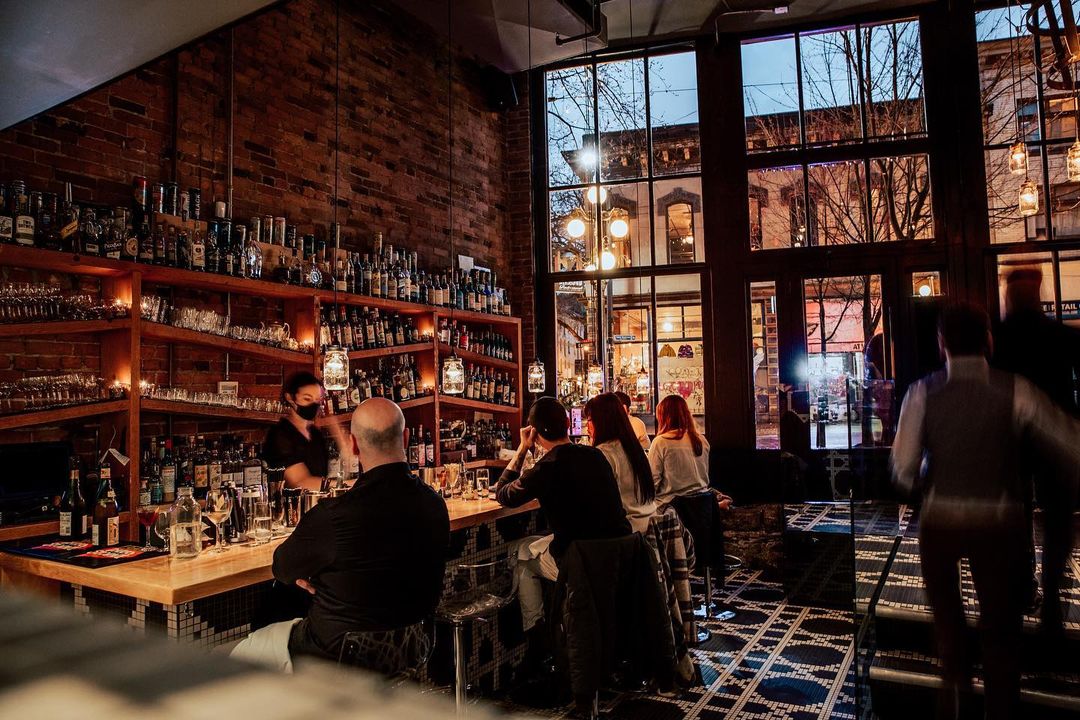
Type: French
Gastown’s best special-occasion restaurant, this candlelit, brick-lined spot makes an art of attending to every detail. Be careful not to fill up on starters of seared scallops and baked oysters before tucking into their eye-rollingly delicious French-influenced West Coast mains, ranging from honey-glazed duck to roasted lamb saddle.
Don’t forget cocktails; there’s a serious commitment to top-notch libations here. Reservations are recommended. There’s also a popular and comparatively well-priced weekend brunch service if you want to start the day off in style.
Home to some of Vancouver’s best bars, Gastown’s atmospheric old brick buildings have been revitalized with distinctive watering holes in recent years, making this an ideal spot for an easy pub crawl. And don’t forget about Chinatown, which also has a choice bar or two of its own.
Type: Pub
Vancouver’s best craft-beer tavern pours a near-legendary roster of 50-plus drafts, many from celebrated BC breweries including Four Winds, Yellow Dog and Dageraad. Hipsters and veteran-ale fans alike love the ‘frat bat:’ choose your own four samples or ask to be surprised. Check the board for new guest casks and stick around for a gastropub dinner at one of the chatty long tables. Food-wise, the jalapeno chicken ‘samwich’ lures heat fans but weekend brunch is also recommended (arrive early). There’s a slender patio for alfresco summer quaffing, and the cavelike downstairs area is ideal for rainy-day hunkering. Also ask about Brassneck, Alibi’s affiliated and arguably even-more-popular microbrewery location on Main St.
Type: Bar
This cavelike subterranean bar, beneath Gastown’s brick-cobbled sidewalks, is also a brilliant venue to catch a tasty side dish of live music. Most shows are pay-what-you-can and can range from trumpet jazz to heartfelt singer-songwriters. Drinks-wise, there’s a great cocktail list plus a small array of draft beers (and many more in cans and bottles). Avoid weekends when there are often lineups. In-the-know locals love this place and it’s easy to slide into the vibe and stick around far longer than you had planned.
Type: Coffee
Gastown’s coolest see-and-be-seen coffee shop, Revolver has never lost its hipster crown. But it’s remained at the top of the Vancouver coffee-mug tree via a serious commitment to serving expertly prepared top-quality java. Aim for a little booth table or, if they’re taken (they usually are), hit the large communal table next door.
Type: Bar
Head upstairs via the unassuming entrance to discover one of Vancouver’s warmest little brick-lined cocktail bars. A glowing, wood-floored heritage room studded with sash windows – try for a view seat – it’s popular with local coolsters but is rarely pretentious. A list of perfectly nailed premium cocktails ($11 to $15) helps, coupled with a diverse tapas menu, tasty flatbreads included.
Check out the lovely crystal chandeliers here, antiques from a bygone age, and try to spot the statue of Gassy Jack atop a whiskey barrel across the square. If you have enough to drink, he might even talk to you. During the 5:30pm to 7:30pm daily happy hour, some cocktails are reduced by $4.
Type: Bar
Gastown’s coziest tavern, you can cover all the necessary food groups via the carefully chosen draft- and bottled-beer list here. There’s a small, animated summer patio out front but inside (especially upstairs) is great for hiding in a chatty, candlelit corner and working your way through the brews – plus a shared small plate or three (we like the sausage board).
It seems right and proper to also have a whiskey here; that’s Gassy Jack’s statue outside, perched atop a barrel, and he started the city with his first bar just a few steps from where you are now. The history doesn’t end there, though. Six Acres is located in the Alhambra Building, one of the city’s oldest structures.
Type: Bar
Tucked along a cobbled back alley reputedly named after the area’s former butchers, this atmospheric little brick-lined wine bar offers dozens of interesting tipples, mostly available by the glass. From your communal table, peruse the large blackboard of house-cured meats and regional cheeses, then go for a $16 tasting plate of three, served with piquant condiments including Brit-style piccalilli.
You can also extend the tasting approach to your libations: three-glass tasting flights of wine, mead or sherry are $15.
Type: Bar
Tucked along a Gastown side street, the red-painted facade fronts one of the city’s most intimate live music resto-bars, a brick-lined cave of small tables, a tiny performance area and the kind of immersive cocktail list that will have you settling in for a night of Southern-style bacchanalian fun. Jazz, blues and more hits the corner ‘stage’ six nights a week.
Reservations are recommended and there’s a supper club approach here that includes a menu of Cajun-influenced comfort food.
Type: Coffee
At this charming window-hatch servery loved by in-the-know locals, order your americanos“flat whites or more from the friendly young Japanese-expat couple running this place and you’ll likely find yourself popping back more than a few times. Delicious matcha lattes, complete with artfully etched green foam, are also popular and they’re the perfect way to fuel-up for a Gastown on-foot exploration.
Type: Pub
Sun-Thu, 11:30am-2am Fri & Sat; W; g4) Belying the clichés about expat Irish bars (except for its reclaimed Guinness barrel floor), the Heather is one of Vancouver’s best gastropubs. Alongside lovingly prepared sausage and mash, and corned beef with braised cabbage, you’ll find good craft beers and, of course, some well-poured stout. Looking for happy hour?
Whiskey fans will also be gobsmacked by the array of tipples in the back-room Shebeen bar. It’s the kind of place where you could settle in for hours and still be there a week later, as merry as a giddy kipper.
Type: Coffee
Blink and you’ll miss the entrance to this small but perfectly formed mosaic-floored cafe, which includes a busy coffee-roasting operation. It’s ” “worth popping in to combine an excellent espresso with some delectable single-origin chocolate treats, also made on-site. It’s a social enterprise providing training and employment for women who live in this area, and the service is sparklingly friendly.
Type: Brewery
This huge brewpub on the edge of Gastown serves several own-made beers, including crisp pilsners, hoppy IPAs and small-batch seasonals. But the best of the bunch is the malty pale ale, ideal for slow afternoon quaffing at an alfresco table (aim for a view of the mountains). Popular with tourists and clocked-off office workers, there’s also an inviting pub-grub menu.
Type: Tavern Patio
A large, loud and fun exposed-brick tavern dominating one side of Maple Tree Sq, this is Gastown’s best summer-patio spot. There’s a good array of BC craft beer to plunge into (from Parkside to Parallel 49) plus a hearty burger-dominated menu that adds heaping brunch options on weekends. It’s jammed on Friday and Saturday nights, so consider a weekday visit instead.
Type: Pub
This short walk will take you on a merry weave around Gastown’s best watering holes and give you a glimpse of the city’s nightlife scene.
Start your crawl at the western end of Gastown (near Waterfront SkyTrain station) with an oatmeal stout at 1Steamworks Brew Pub, one of the city’s few brewpubs. Enjoy the downhill slope east along Water St and you’ll soon arrive at Maple Tree Sq. This is where Gassy Jack triggered the city by building his first saloon – tip your hat at the 2statue of him here, then duck underground to 3Guilt & Co for a bottled beer and a board game.
Back outside, nip across the square to 4Six Acres, one of the area’s coziest hangouts. You’ll be tempted to stick around, but the spirit of Gassy will be calling you back to the streets.
Stroll across Carrall St and duck into the 5Irish Heather. It’s the best spot in town for a Guinness. If you’re still walking by this stage, return to Carrall, walk north for a few seconds and turn right onto Powell St. A street sign will point you to the unassuming stairwell that leads to the 6Diamond, a great spot for perfect cocktails. Look for Gassy’s statue through the window. If he doffs his hat, you’ve probably had too much to drink.
But if not, head back out and take Alexander St eastwards. Within a couple of minutes you’ll reach the 7Alibi Room. This is the city’s favorite craft-beer bar, and a great spot to end your evening with a ‘frat bat’ of sampler brews.”
Gastown is more about the bars but Chinatown is home to some decent entertainment options, including a couple of local-fave live venues. Converse with a few Vancouverites here and ask for recommendations about what’s coming up and who’s about to hit the stage.
Type: Theater
One of the leading players in Vancouver’s independent-theater scene, this intimate, studio-sized venue is located inside a historic former fire station. It presents culturally diverse contemporary drama and dance, with an emphasis on emerging talent. A key venue during July’s annual Dancing on the Edge festival (www.dancingontheedge.org), it also has a convivial licensed lounge on-site.
Check out the artworks lining the brick walls before you go in for your show; there’s typically a focus on intriguing local artists.
Type: Live Music
Revamped from its grungy 1970s incarnation, the funky Rickshaw shows that Eastside gentrification can be positive. The stage of choice for many punk and indie acts, it’s an excellent place to see a band. There’s a huge mosh area near the stage and rows of theater-style seats at the back.
Check the schedule to see who’s on; many nights there are several bands on the roster.
Type: Live Music
The Downtown Eastside’s most-accessible dive bar started a century ago and, in recent years, it’s dusted off the jazz chops that saw Jelly Roll Morton play here back in the day. Monday night sees no-cover jazz shows from 7:30 pm, while there are often other cover-free jazz and blues happenings throughout the week. Check the pub’s website calendar for events.
The good-value beer menu includes house-made ales from Hastings Mill Brewing; check out any available seasonals or dive straight into their Skid Road IPA. The food here is a cut above typical pub fare – pulled pork poutine, for example – with almost everything on the menu priced under $12.
Type: Cinema
Incongruously located on the 3rd floor of a usually half-empty Chinatown shopping mall, this popular Vancouver theater combines blockbuster and art-house offerings and is often used for film festivals. Comfy stadium seating is the norm here, and it’s ideal for sheltering on a rainy Vancouver day with a large coffee and a case of Glosette Raisins.
Type: Walking
A guided four-hour wander with third-generation Chinese-Canadian Vancouverite Robert Sung, this entertaining walk explores the culinary and cultural sides of Chinatown. The good-value fee includes visits to local landmarks and traditional stores as well as a dim-sum lunch and entry to the Dr Sun Yat-Sen Classical Chinese Garden. There’s also a Granville Island Public Market tour, samples included, for $50.
Type: Walking
If your criminal interests are triggered by the Vancouver Police Museum & Archives, take one of their excellent Sins of the City walking tours, which weave through Gastown and Chinatown in search of former brothels, opium dens, gambling houses and more. The tours last up to two hours and are a great way to see the far-less-salubrious side of the shiny, glass-towered metropolis.
Type: Museum
Barclay and Broughton Sts., West End. t 604-684-7040. www.roeddehouse.org. Open for tours year-round; call for longer hours and special occasions in summer. Open May–Aug daily 10am–4pm. Rest of the year daily1pm–4pm. $5; $8 for Sun afternoon tea and tour.
Quiet Barclay Heritage Square—just one-block in size—and the neighbourhood surrounding it hint at the “quality of life that existed in Vancouver’s West End a century ago.
The highlight of this area is the opulent, fully restored 1893 Queen Anne Revival-style mansion, Roedde House. Built for Vancouver bookbinder Gustav Roedde and his family, the house is thought to have been designed by Francis Rattenbury, the architect responsible for the Parliament Buildings and the Empress Hotel in Victoria (see Excursions). The home’s most distinctive feature is its rooftop cupola. It was from here, at the end of the 19C, that residents could watch the sea lanes for incoming vessels. Now, alas, West End development has blocked the view.
The 11 rooms in the interior of the house are furnished to depict the middle-class lifestyle of an immigrant family in the late 19C. In the adjacent park you’ll find a Victorian garden; visit in spring (Mar–Jun) to see the blooms of dozens of mature rhododendrons cascade down the huge bushes like coloured waterfalls.
Some locals claim that Vancouver doesn’t have much of an arts scene. But if you’re visiting in November and you know where to look, you’ll have possibly the artiest weekend of your life. During the annual Eastside Culture Crawl (www.culturecrawl.ca; hmid-Nov), hundreds of local artists open their studios, houses and workshops for free to art-loving visitors who wander from site to site, meeting the creators, hanging with artsy chums and even buying the occasional well-priced gem. Festival locations stretch eastwards from the north end of Main St and visitors spend their time walking the streets looking for the next hot spot, which is typically just around the corner.
You’ll find full-time artists working on commissioned installations as well as artisans noodling away in their spare bedrooms. There’s an almost partylike atmosphere in the streets during the weekend, especially if the rain holds off. Look out for the occasional street performer keeping things lively and incorporate a coffee-shop pit stop or two along the way. The event is a great opportunity to buy one-of-a-kind artwork souvenirs for that difficult person back home (you know the one).
Head to the website to plan your route, although we recommend just wandering and following the crowds to see what you
Once lined with tacky souvenir stores (there are still a few here), Gastown has been increasingly colonized by designer boutiques, making this area a downtown rival to Main St in the indie shopping stakes. While Chinatown’s ever-colorful streets used to be more for looking at than actually shopping – how many live frogs do you usually buy? – it’s also home to its own cool indie stores.
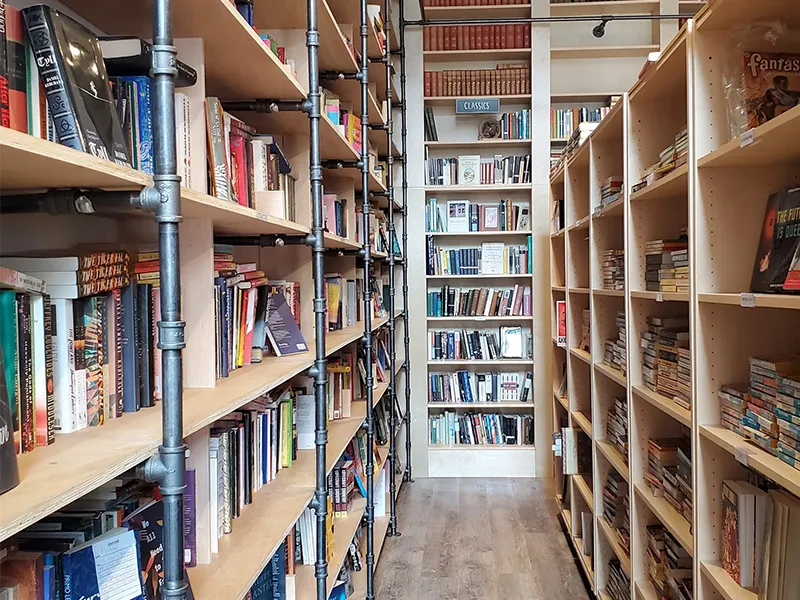
Type: Books
A former pop-up favorite with a now-permanent Chinatown location, this delightful bookstore is lined with tall stacks of well-curated, mostly used titles. There’s an impressively large selection of indigenous-themed books, alongside good selections covering travel, history and literature – plus a bargain $1 cart outside. Love mysteries? Try finding the store’s secret room, hidden behind a pushable bookcase door.

Type: Market
A size upgrade from its previous venue has delivered a cavernous market hall of hip arts and crafts-isans hawking everything from handmade chocolate bars to intricate jewelry and a humungous array of cool-ass vintage clothing. Give yourself plenty of time to hang out here; here’s a pool table and retro arcade machines plus food trucks and a long bar serving local craft beer. It’s $3 for entry but $5 buys you an all-weekend pass.
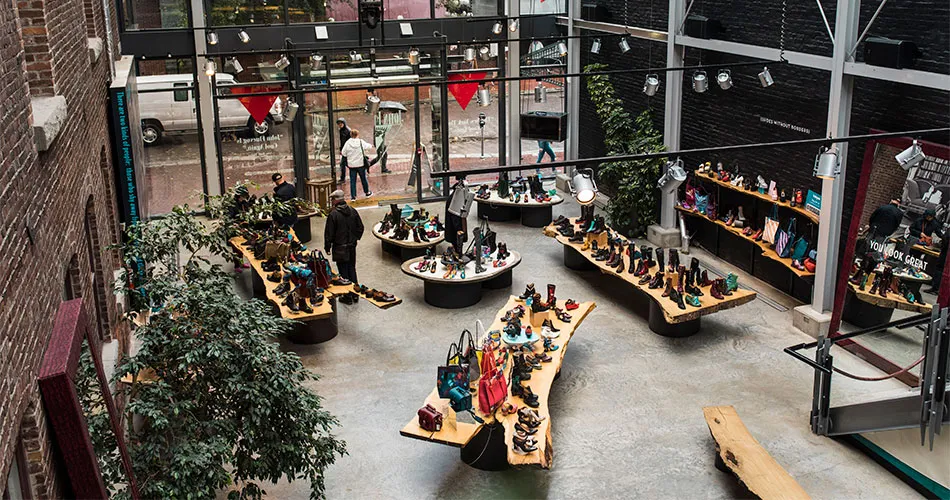
Type: Shoes
Like an art gallery for shoes, this alluringly cavernous store showcases the famed footwear of local designer Fluevog, whose men’s and women’s boots and brogues are what Doc Martens would have become if they’d stayed interesting and cutting-edge. Pick up that pair of thigh-hugging dominatrix boots you’ve always wanted or settle on some designer loafers that would make anyone walk tall.

Type: Music
Like hanging out with a buddy and checking out his cool record collection, dropping in for a chat with store-owner Dale at this tiny, vinyl-lined store is a delight. Peruse the jam-packed racks of brilliantly curated albums yourself or ask for help to find that 7-inch Inspiral Carpets picture disk you let slip through your hands all those years ago.
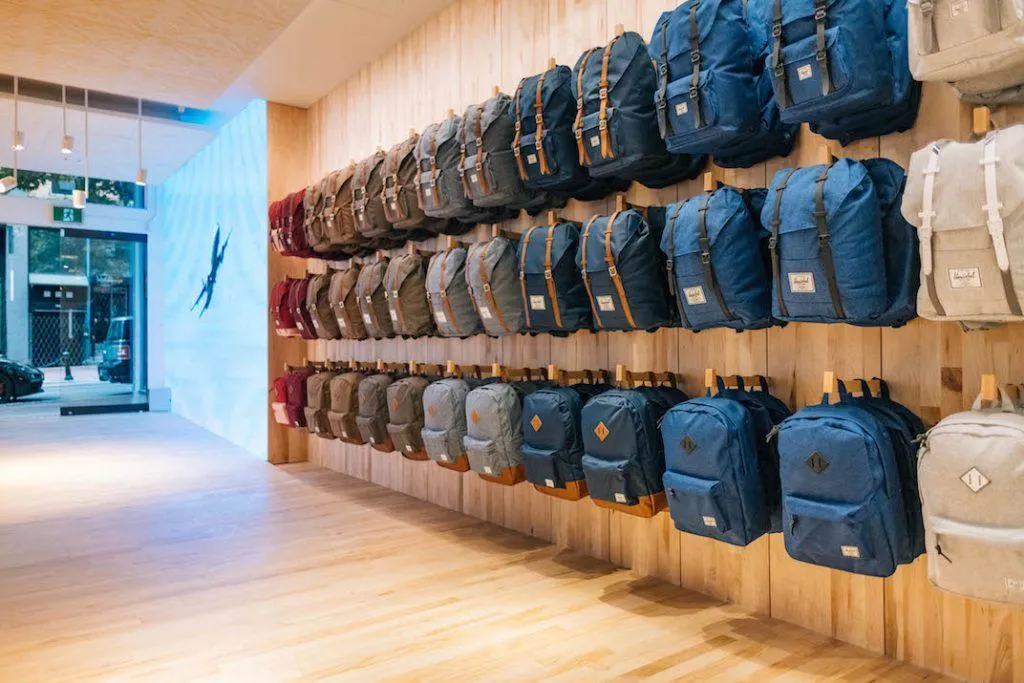
Type: Fashion & Accessories
The friendly flagship store of this hot, Vancouver-based bags-and-accessories brand is a must-see for Herschel fans. Inside a beautifully restored, artwork-lined Gastown heritage building (check out the waterfront views from the back windows), you’ll find a huge array of the company’s signature daypacks, plus wallets, totes, pouches and recently added clothing lines. Give yourself plenty of perusing time; you’re gonna need it.
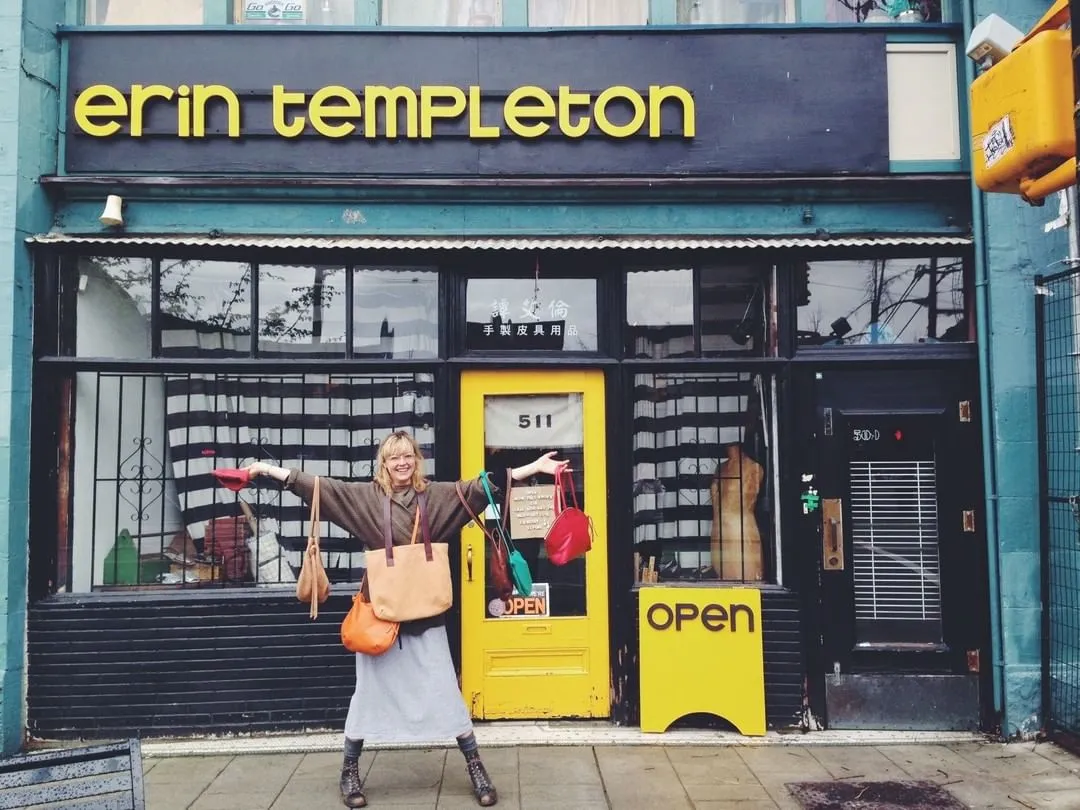
Type: Fashion & Accessories
Known for recycling leather into hip, super-supple bags, belts, hats and purses, this eponymous store has a cult following. Erin herself is often on hand and happy to chat about her creations (she trained in shoemaking at a London college). They’re the kind of must-have, one-of-a-kind items that are hard to resist, no matter how many bags you already have back home.
The idea here is to marry form and functionality; locals rave about how “ how long their purses last, and if anything does break, it’s often fixed for free by Erin herself. Check the website for the full range and all her most recent designs. Near the front of the store, there are also some racks of carefully curated vintage clothes to check out.
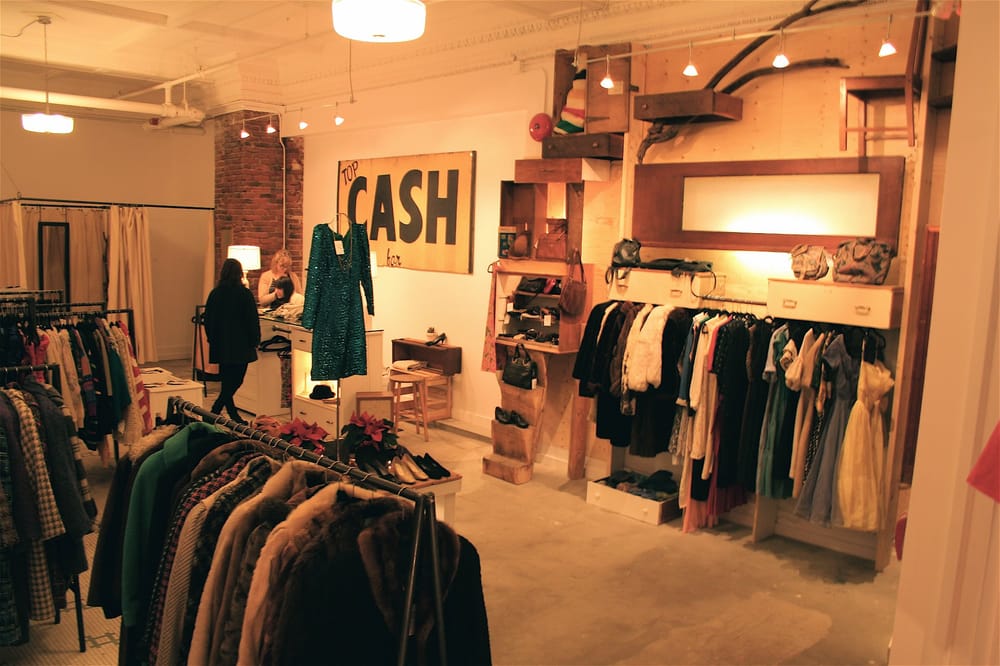
Type: Froch Shop Vintage
A nonprofit social enterprise selling a cornu-copia of vintage women’s clothing, from 1970s print dresses to elegant silk tops to printed T-shirts of old bands you may never have heard of. Spend plenty of time browsing and trying out a few new looks here, and don’t forget to peruse the quirky local-made jewelry as well.
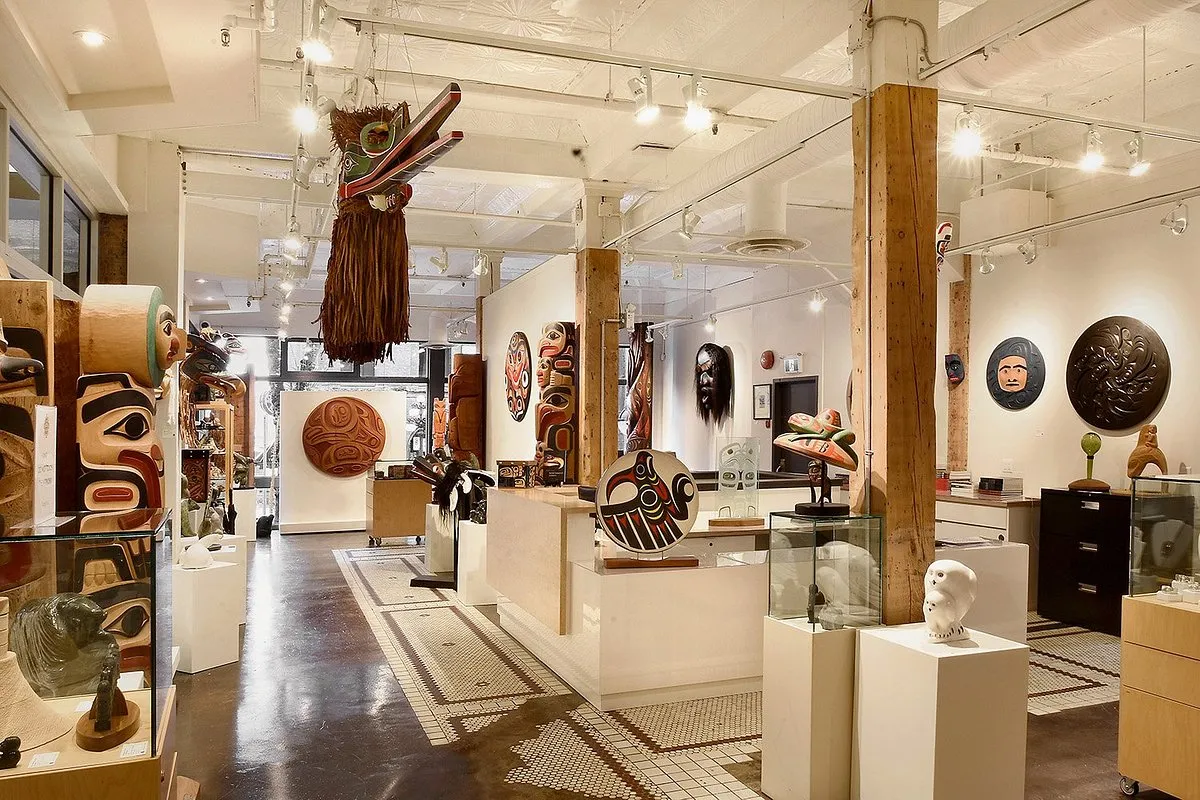
Type: Fine & Crafts
This two-level museum-like store showcases an eye-popping array of Inuit and Northwest Coast indigenous jewelry, carvings and prints. On the high-art side of things, the exquisite items here are ideal if you’re looking for an extra-very-special souvenir for someone back home. Don’t worry; they can ship the totem poles if you can’t fit them in your suitcase.
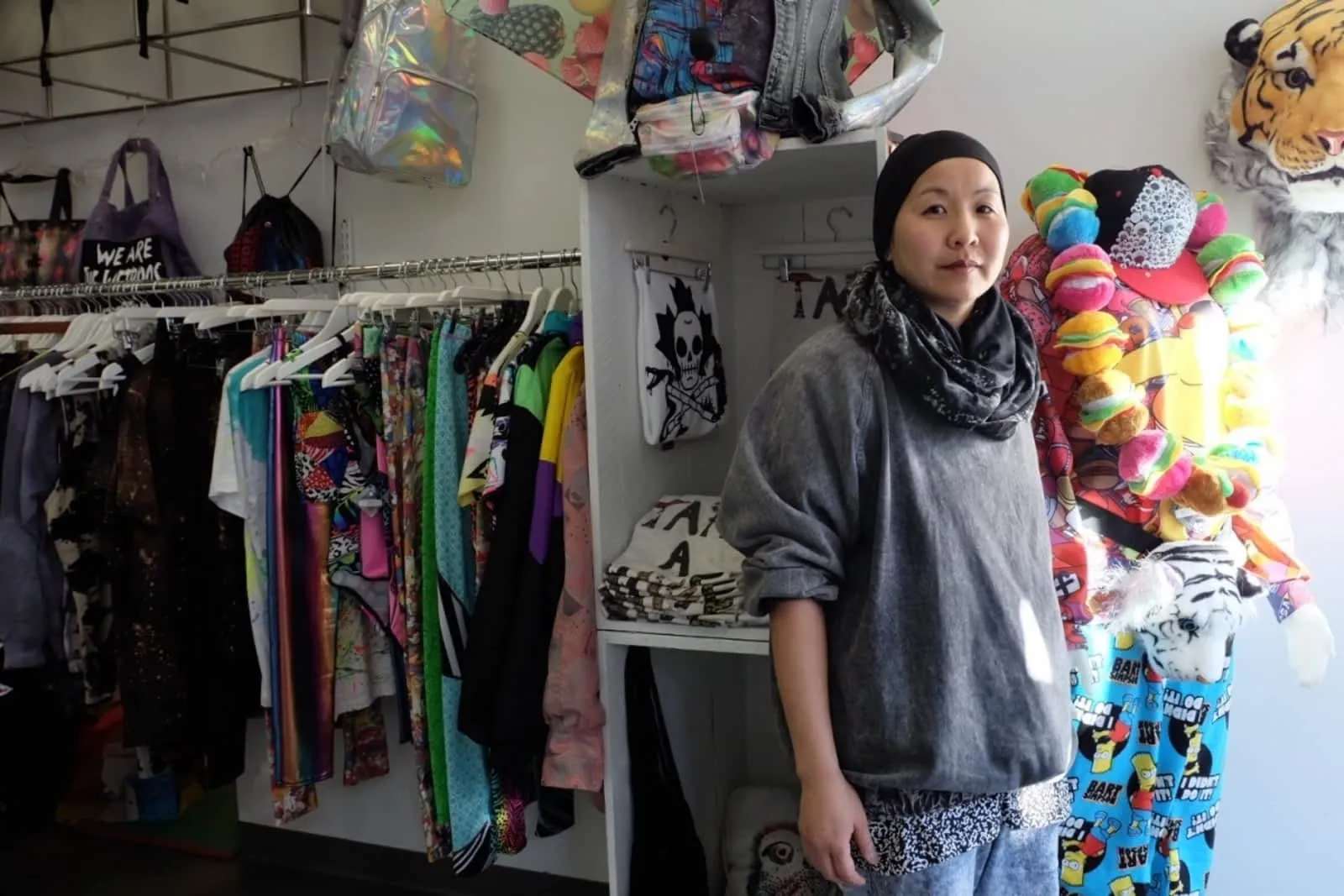
Type: Craft Markets
Crammed with locally made bright-hued T-shirts, backpacks and ball caps, Blim’s main business is the roster of workshops on everything from patch-making to ceramic screen printing. Check to see what’s on – or just buy someone else’s handiwork from the shop and pretend it’s yours. Look out for resident cat Pounce, who likes to bolt for the door whenever possible. Blim also stages craft markets at sites around the city; they’re a great way to meet local artisans and pick up unique souvenirs. Check the website.
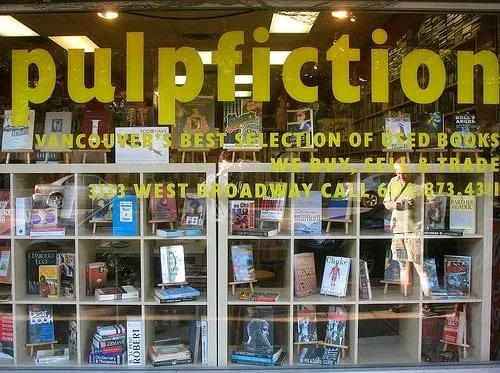
Type: Books
When Massy Books opened as an under-the-radar pop-up bookstore on Main Street in 2017, digital-embracing locals wondered how a place selling what seemed to be an old-fashioned, even obsolete item could possibly last. But the store was a huge success and, when its temporary lease later expired, they reopened in a permanent Chinatown storefront location in 2018. But they’re not the only bookstore that’s doing well in Vancouver: don’t miss downtown’s Paper Hound, Kitsilano’s giant Kidsbooks and the three branches of Pulpfiction Books
For a free,no-obligation,consultation simply emails us your details and requirements to info@globalduniya.ca and we will get straight back to you with some ideas and suggestions.
If you like my ideas for a tour we can comeup with a more detailed plan, by email or phone at +17788821450,before you decide.
Q1: What is Gastown in Vancouver known for?
A1: Gastown is known for its historic charm, cobblestone streets, Victorian architecture, trendy shops, vibrant art scene, and bustling restaurant and bar scene. It's often considered the birthplace of Vancouver and is famous for its iconic Steam Clock.
Q2: What are some must-visit attractions in Gastown?
A2: Some must-visit attractions in Gastown include the Steam Clock, the famous "Gassy" Jack statue, the Vancouver Lookout for panoramic city views, the Blood Alley for its unique shops and eateries, and the Gastown Mural Festival showcasing impressive street art.
Q3: Are there any notable restaurants or cafes in Gastown?
A3: Yes, Gastown is renowned for its diverse culinary scene. You'll find a wide range of restaurants and cafes offering various cuisines, including local Pacific Northwest fare, international flavors, craft breweries, cocktail bars, and cozy coffee shops.
Q4: Can I shop for unique items in Gastown?
A4: Absolutely! Gastown is known for its eclectic boutiques and shops. From trendy fashion stores to independent art galleries, vintage shops, and unique home decor stores, there's something for everyone's taste and style.
Q5: Are there any events or festivals in Gastown throughout the year?
A5: Gastown hosts several events and festivals throughout the year, including the Gastown Grand Prix cycling race, the Gastown Blues & Chili Festival, the Gastown Thursday Nights with extended store hours and live entertainment, and the annual Gastown Steam Clock Lighting to kick off the holiday season.